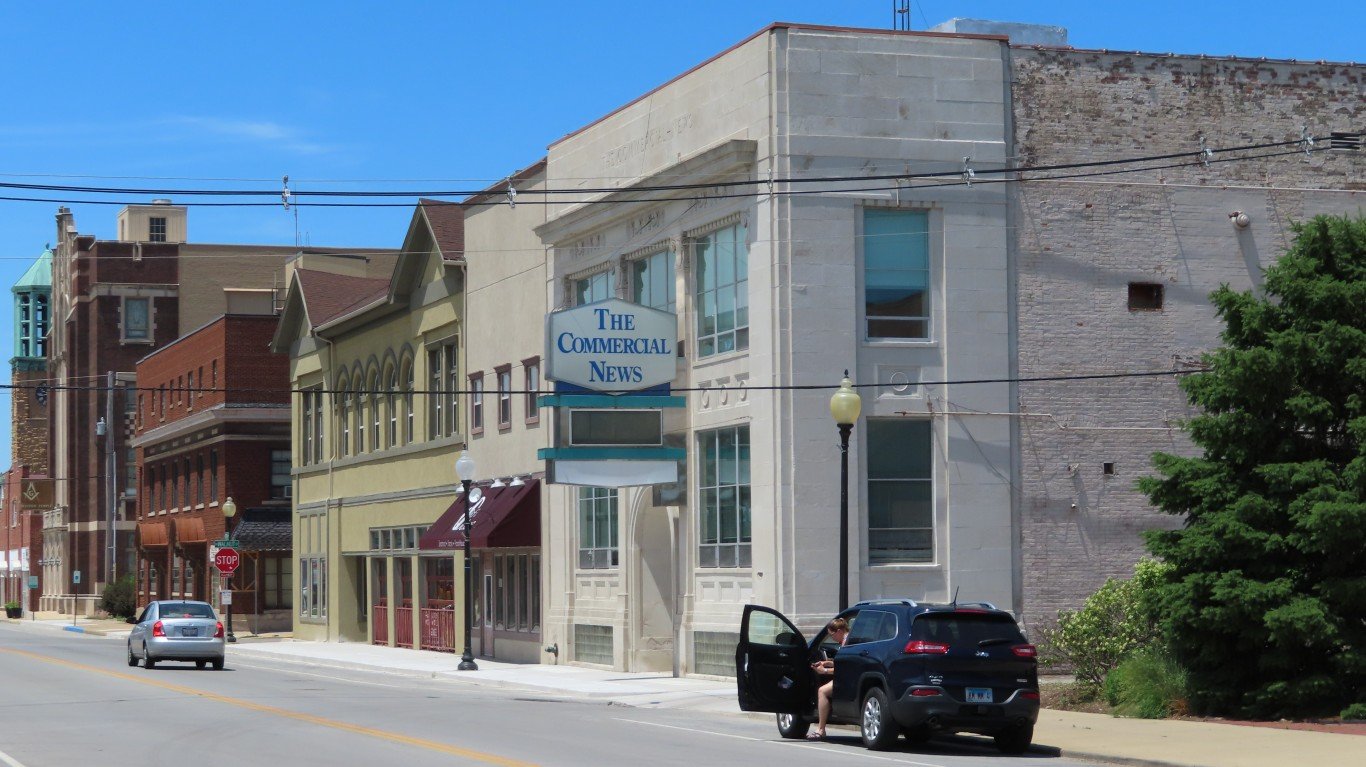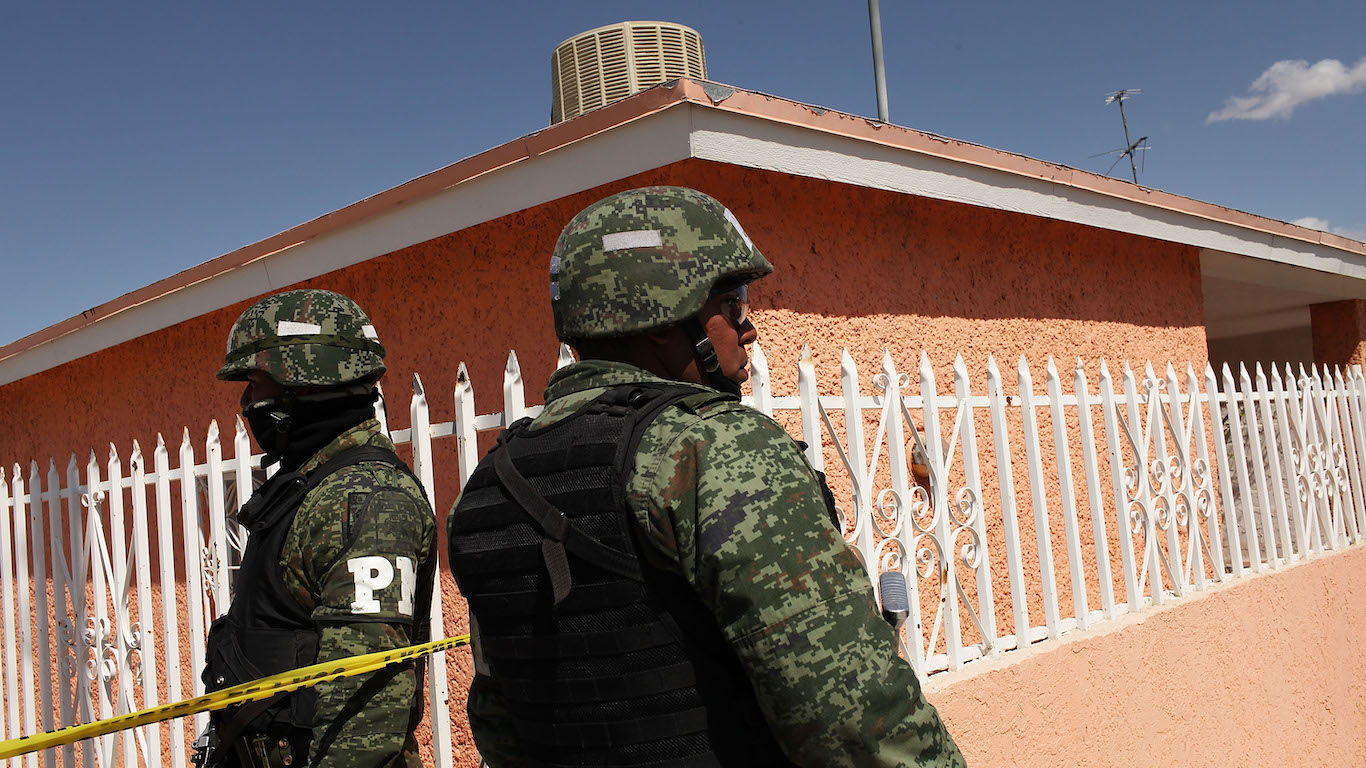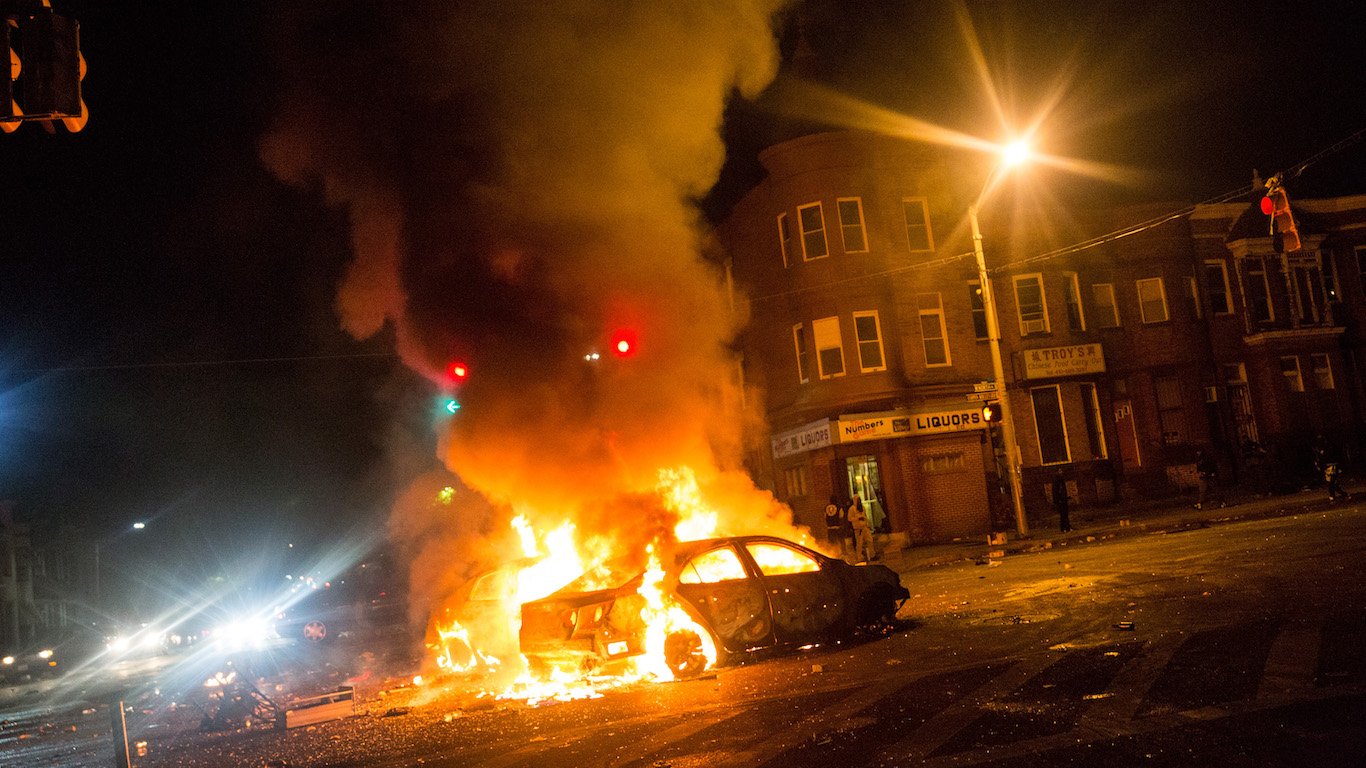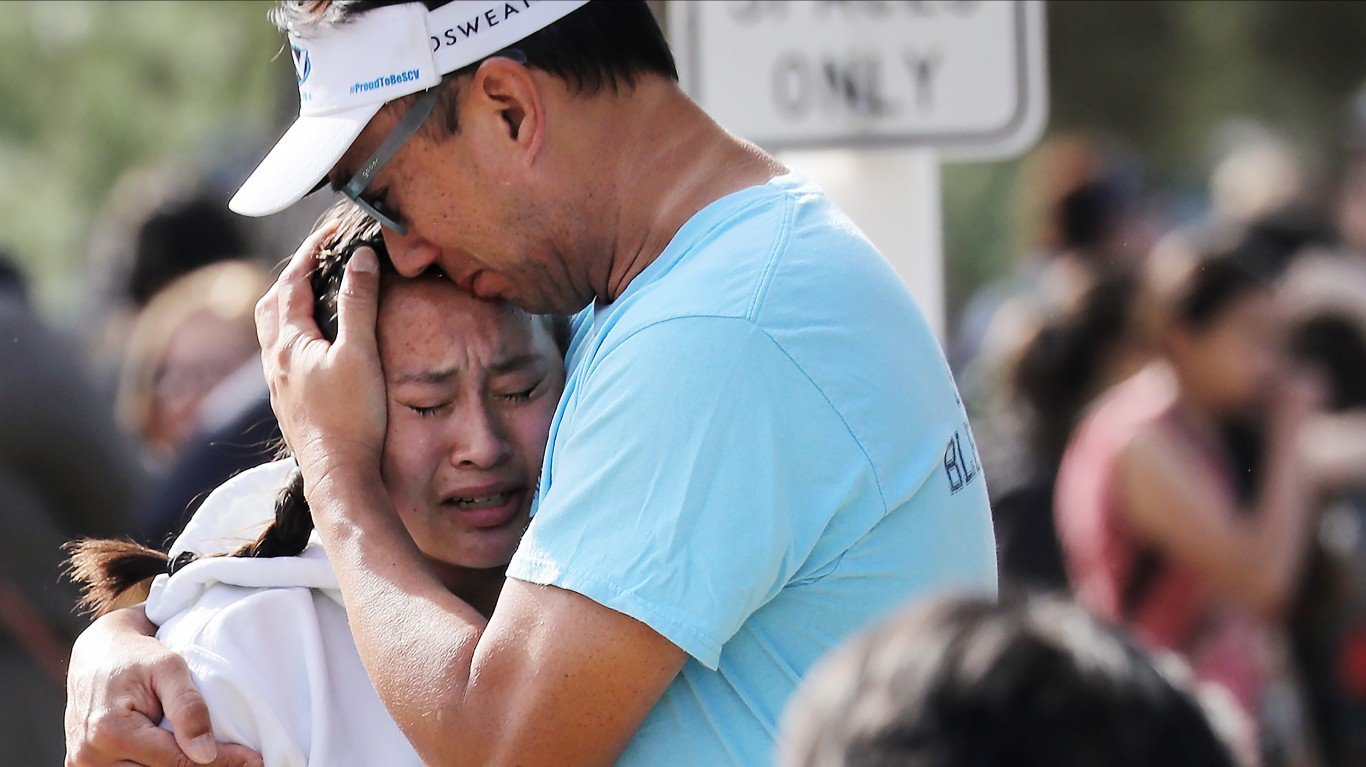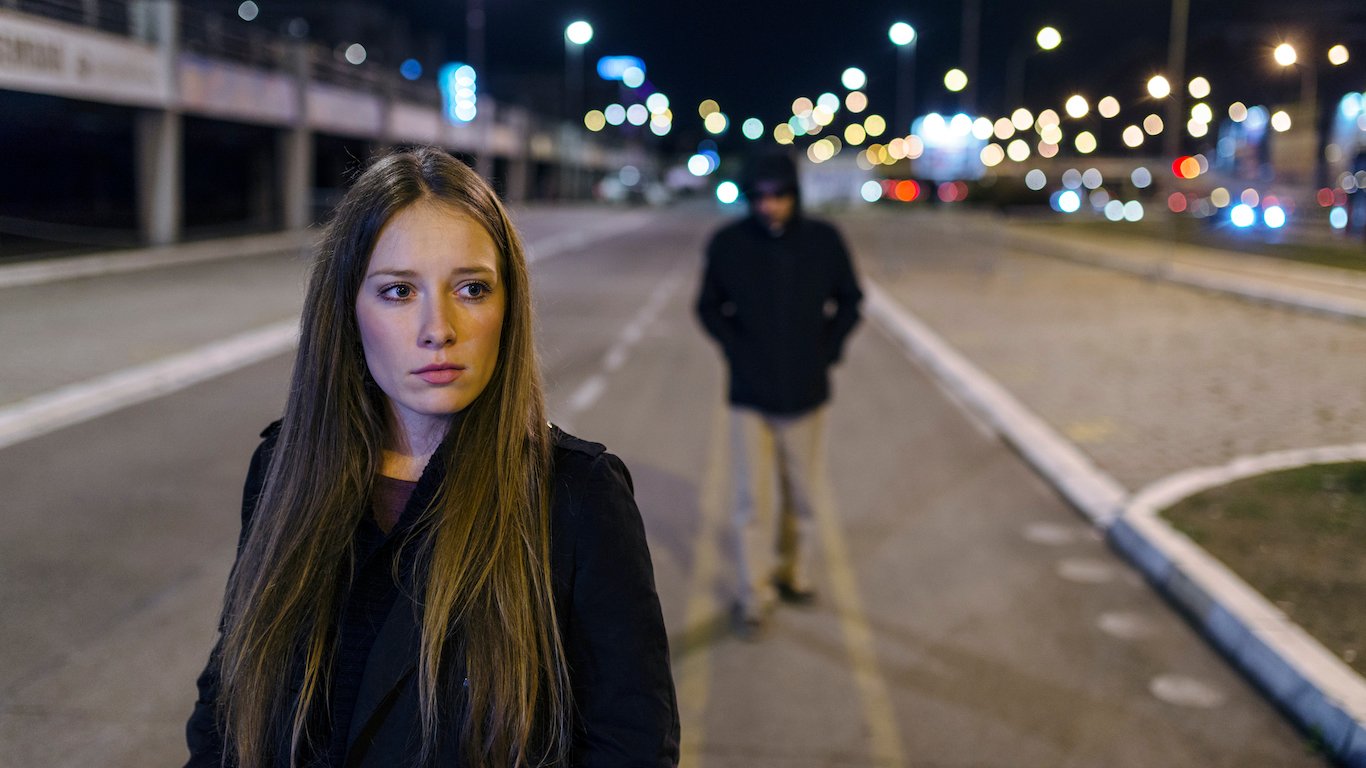

The U.S. violent crime rate — an annual, population-adjusted measure of cases of rаpe, robbery, aggravated assault, and homicide — grew by 5% in 2020. The increase was driven by a rise in aggravated assault and, most notably, a historic 29.4% surge in homicides that made 2020 the deadliest year in the United States since the mid-1990s.
Despite the largest single-year increase in homicides, the overall violent crime rate in 2020 remains relatively low by historical standards. There were 1.3 million violent crimes reported in the U.S. in 2020, or 399 for every 100,000 people. For context, the violent crime rate ranged between 523 and 758 incidents per 100,000 throughout the 1990s.
Of course, crime is a local phenomenon influenced by a wide range of factors at the national, state, community, and even household level. As a result, violent crime rates in the U.S. can vary considerably from place to place — and in some metro areas, rates of violence far exceed the nation-level highs recorded in decades past.
Using data from the FBI’s 2020 Uniform Crime Report, 24/7 Wall St. identified the 50 most dangerous metro areas in the United States. Metro areas are ranked by the violent crime rate — specifically, the number of violent crimes reported for every 100,000 residents.
In keeping with the national trend, the majority of metro areas on this list reported a rise in criminal violence in 2020. As was also the case nationwide, the increase in many of these metro areas was led by a surge in homicide cases. Here are the 50 cities where homicide is soaring.
Explanations for the high levels of violence in these places are varied and complex. Major current events that have reached every corner of the country — such as the COVID-19 pandemic and unrest fueled by the murder of George Floyd — have likely played a role in some places. Other factors, such as a lack of economic opportunity, are more endemic.
Low-income communities in the United States are disproportionately burdened by crime. One study found that individuals with family incomes of less than $15,000 annually are three times more likely to be victimized by crime than those with family incomes of $75,000 or more. In all but a handful of metro areas on this list, the share of residents living on poverty level income exceeds the 12.3% national poverty rate. Here is a look at the city hit hardest by extreme poverty in every state.
Click here to see America’s 50 most dangerous metropolitan areas
To determine the 50 most dangerous metro areas in America, 24/7 Wall St. reviewed violent crime figures from the FBI’s 2020 Uniform Crime Report. Violent crime includes murder, non-negligent manslaughter, rаpe, robbery, and aggravated assault. The rate of violent crimes per 100,000 people was calculated using population data from the FBI.
Limited data were available in the 2020 UCR for areas in Alabama, Maryland, Pennsylvania, and Illinois, though these places were not excluded from analysis.
Additional information on the number of murders and the population within the jurisdictions reporting figures to the FBI are also from the 2020 FBI UCR. Poverty rates are one-year estimates from the 2019 ACS.

50. Hot Springs, AR
> Violent crime rate: 583 per 100,000 people (582 total crimes)
> 1-yr. change in violent crime rate: +11.3%
> Homicide rate: 9.0 per 100,000 people (9 total homicides)
> Poverty rate: 17.4%
Hot Springs is one of five metro areas in Arkansas to rank among the 50 most dangerous U.S. cities. There were 583 violent crimes reported for every 100,000 people in the metro area in 2020, well above the national violent crime rate. The local violent crime rate is also rising rapidly — increasing by 11.3% in the last year, more than double the national increase.
Crime in the United States is often disproportionately concentrated in poor communities, and in Hot Springs, 17.4% of the population live below the poverty line, compared to 12.3% of the U.S. population.
[in-text-ad]
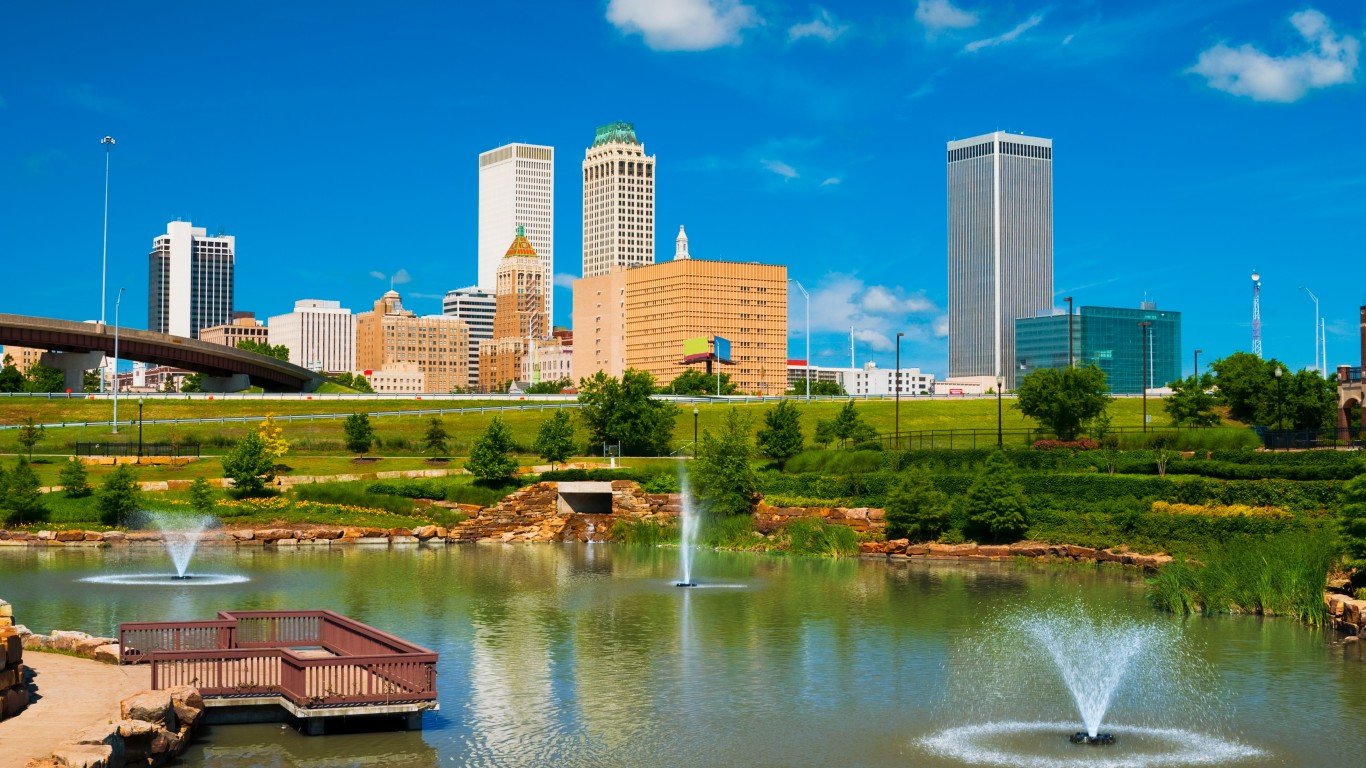
49. Tulsa, OK
> Violent crime rate: 591 per 100,000 people (5,947 total crimes)
> 1-yr. change in violent crime rate: +11.7%
> Homicide rate: 9.3 per 100,000 people (94 total homicides)
> Poverty rate: 13.6%
WIth a violent crime rate of 591 incidents per 100,000 people, Tulsa, Oklahoma, ranks among the 50 most dangerous metro areas in the country. The local homicide rate of 9.3 murders per 100,000 is also among the highest of U.S. metro areas and well above the 6.5 per 100,000 national rate.
Violent crime has risen rapidly in the metro area last year, up nearly 12% over 2019. Some local officials attribute the high and rising crime rates in the area to the COVID-19 pandemic.
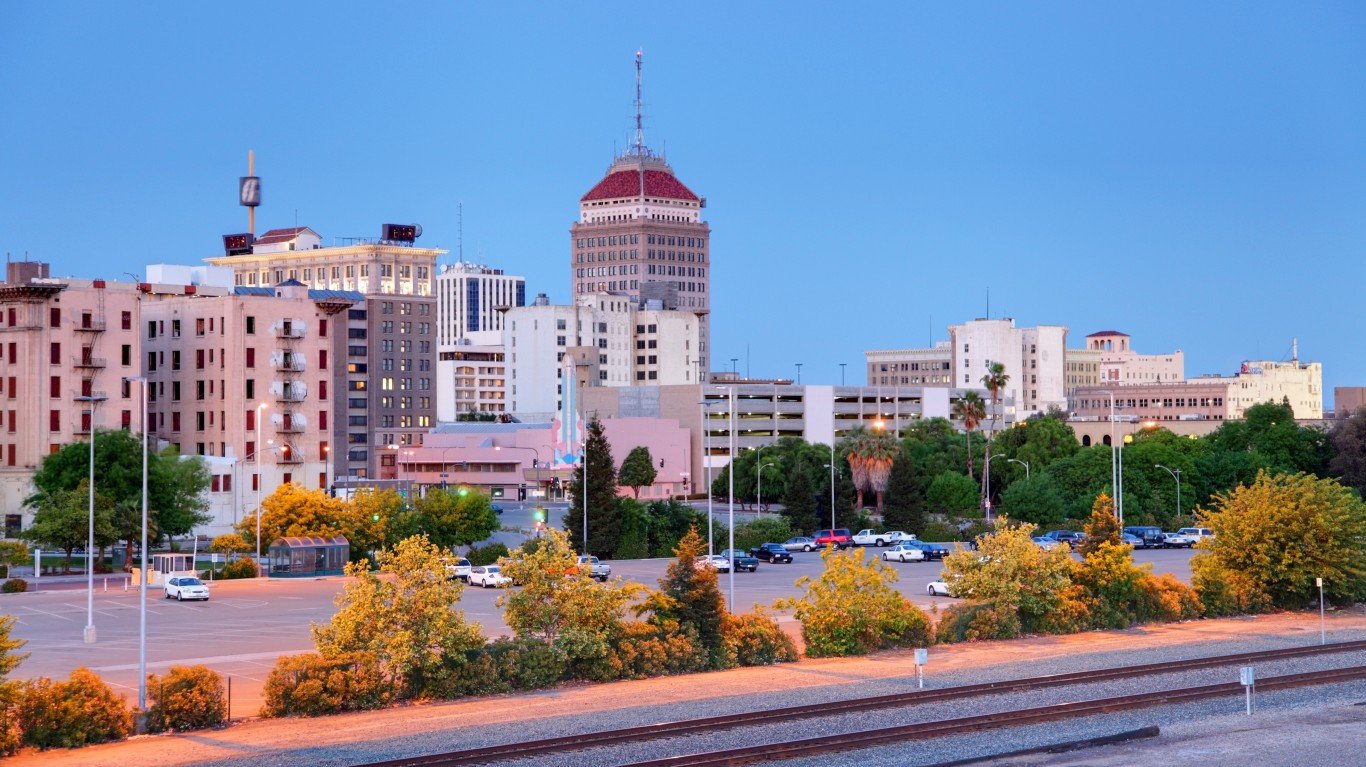
48. Fresno, CA
> Violent crime rate: 597 per 100,000 people (5,948 total crimes)
> 1-yr. change in violent crime rate: N/A
> Homicide rate: 9.4 per 100,000 people (94 total homicides)
> Poverty rate: 20.6%
Fresno is one of four California metro areas to rank among the 50 most dangerous cities in the United States. Nearly 6,000 violent crimes were reported in Fresno in 2020, or 597 for every 100,000 people.
Rates of violence are often higher in places with limited economic opportunity — and in Fresno, 20.6% of the population live below the poverty line and average unemployment in 2020 was 11.3%. This compares to the national 12.3% poverty rate and 8.1% jobless rate that year. Local police point to gang activity as a driver of violence in the area.
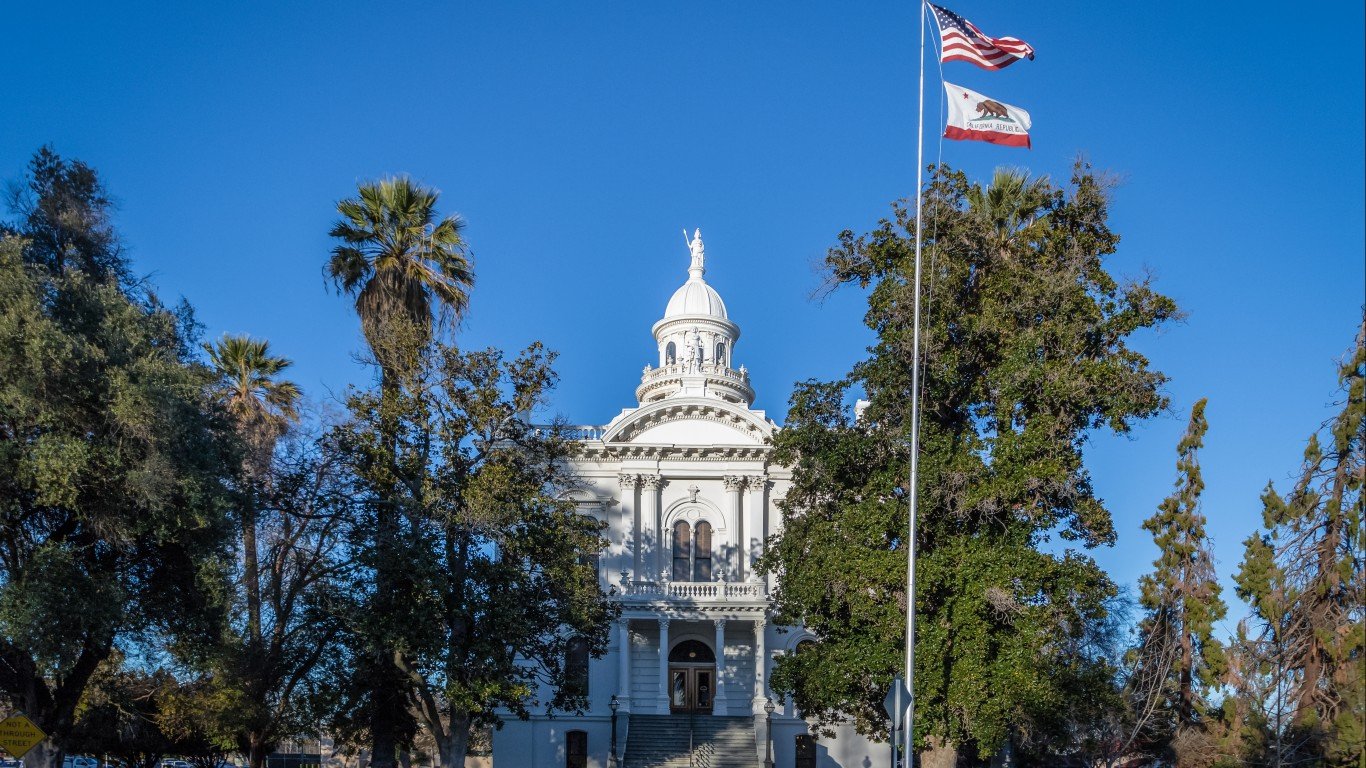
47. Merced, CA
> Violent crime rate: 599 per 100,000 people (1,660 total crimes)
> 1-yr. change in violent crime rate: +8.2%
> Homicide rate: 8.7 per 100,000 people (24 total homicides)
> Poverty rate: 16.8%
Merced is one of several metro areas in California’s Central Valley to rank among the 50 most dangerous cities in the country. A total of 1,660 violent crimes were reported in the metro area in 2020, or 599 for every 100,000 people. Like much of the country, Merced is suffering from a surge in violent crime, particularly homicide. There were 24 murders in the metro area in 2020, double the number reported in 2019. The spike in homicide contributed to an 8.2% increase in the overall violent crime rate.
While violence is on the rise in Merced, property crimes are becoming less common. Over the last year, cases of motor vehicle theft have fallen by 4.1% in the metro area, burglaries were down 10.2%, and cases of larceny theft have declined by nearly 20%.
[in-text-ad-2]

46. Lawton, OK
> Violent crime rate: 603 per 100,000 people (759 total crimes)
> 1-yr. change in violent crime rate: -15.8%
> Homicide rate: 12.7 per 100,000 people (16 total homicides)
> Poverty rate: 17.8%
Lawton is the most dangerous metro area in Oklahoma and one of the 50 most dangerous in the United States. There were a total of 759 violent crimes reported in the metro area in 2020, or 603 for every 100,000 people. The local homicide rate is especially high. With 12.7 murders for every 100,000 people, homicide is nearly twice as common in Lawton as it is on average nationwide.
Rates of violence are relatively high in Lawton despite falling 15.8% since 2019. The decline was driven by fewer reported cases of rаpe and aggravated assault.
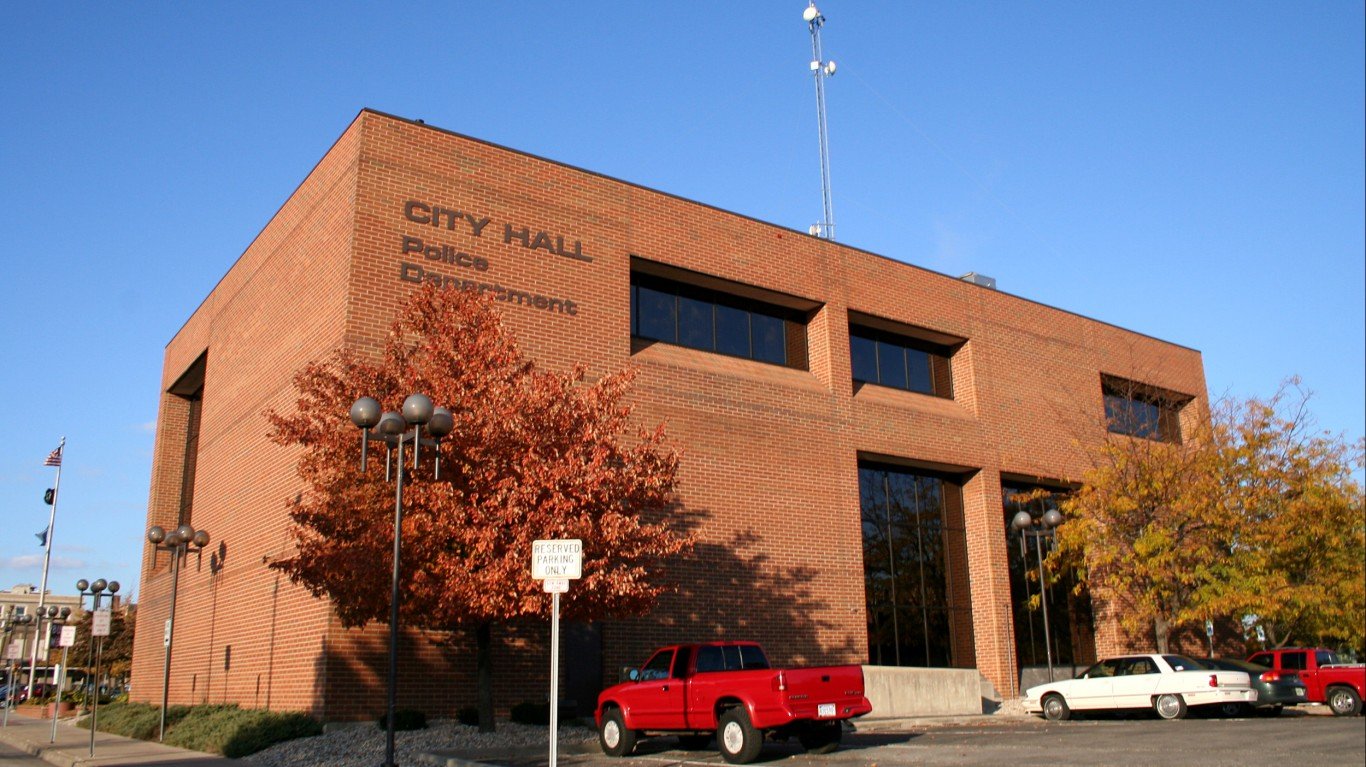
45. Kokomo, IN
> Violent crime rate: 604 per 100,000 people (498 total crimes)
> 1-yr. change in violent crime rate: +8.8%
> Homicide rate: 9.7 per 100,000 people (8 total homicides)
> Poverty rate: 11.9%
The overall violent crime rate in Kokomo, Indiana, climbed 8.8% last year and now stands at 604 incidents per 100,000 people, higher than in the vast majority of other U.S. metro areas. To address the high and rising rates of violence, the Kokomo mayor recently announced the reinstatement of a crime analyst within the city police department. The position was created to take a proactive approach to crime reduction by providing recommendations related to resource allocation through data analysis.
While violence is on the rise in Kokomo, property crimes are becoming less common. Over the last year, cases of motor vehicle theft have fallen by 7.9% in the metro area, while both burglaries and cases of larceny theft were each down by over 20%.
[in-text-ad]
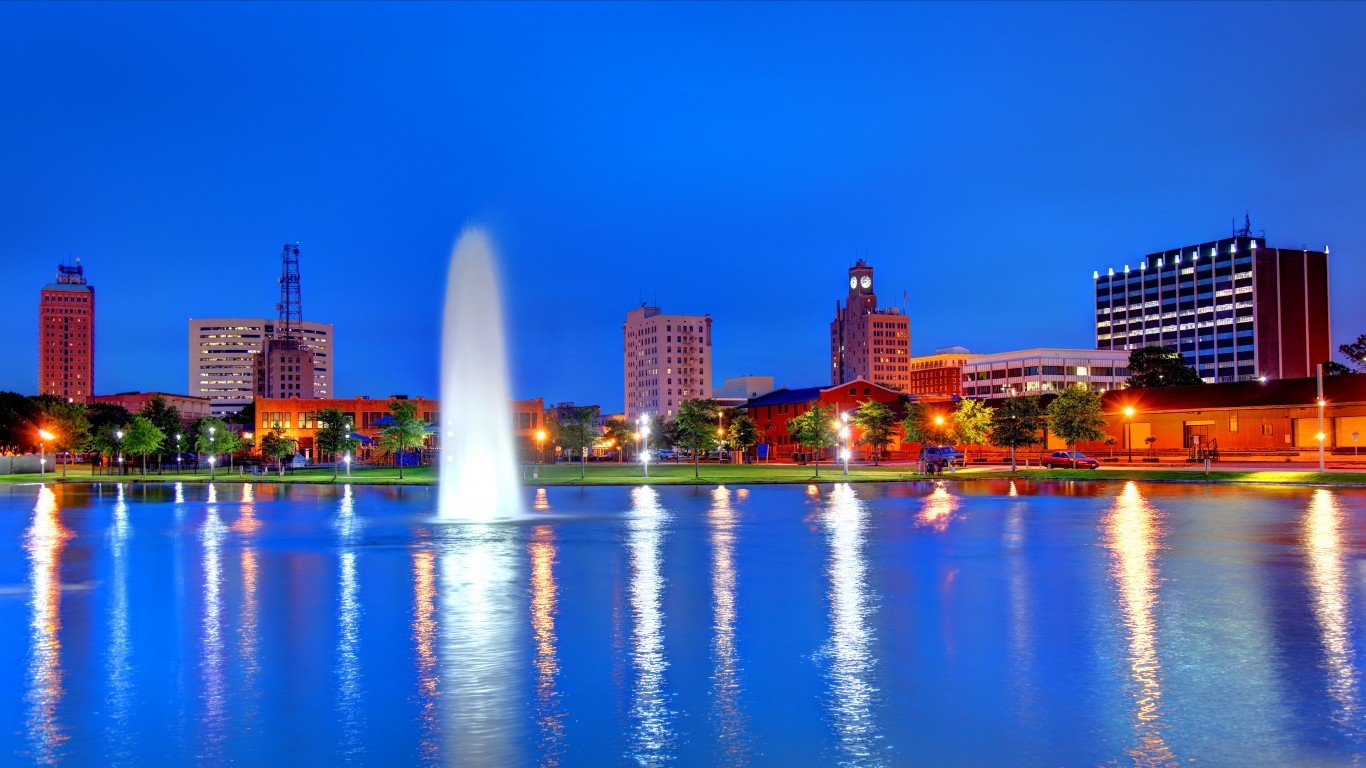
44. Beaumont-Port Arthur, TX
> Violent crime rate: 606 per 100,000 people (2,372 total crimes)
> 1-yr. change in violent crime rate: +11.9%
> Homicide rate: 8.9 per 100,000 people (35 total homicides)
> Poverty rate: 15.0%
Of the 50 most dangerous metro areas in the United States, six are in Texas — more than in any other state. The Beaumont-Port Arthur metro area is one of them, with a violent crime rate of 606 incidents per 100,000 people.
Overall rates of violence in the Beaumont metro area are up by nearly 12% year over year. The district attorney for Jefferson County, Texas, which covers both the cities of Beaumont and Port Arthur, has pointed to pandemic-related delays in criminal trials leading to a backlog of cases and resulting in violent offenders remaining on the street longer than they otherwise would.

43. Chattanooga, TN-GA
> Violent crime rate: 613 per 100,000 people (3,487 total crimes)
> 1-yr. change in violent crime rate: +16.6%
> Homicide rate: 7.9 per 100,000 people (45 total homicides)
> Poverty rate: 12.7%
Nearly 3,500 violent crimes were reported in the Chattanooga, Tennessee, metro area in 2020 — or 613 for every 100,000 people, a 16.6% increase from the previous year. Rising crime rates in the area were led by a 25.0% rise in murder cases and a 34.5% surge in robberies.
Much of the violence in and around the city involves firearms. Chattanooga Mayor Tim Kelly called the scourge of gun violence an epidemic, as shootings the city have continued to rise into 2021. As of early July, there were 114 shootings reported in the city proper, up from 79 at the same time in 2020 and 69 in 2019. Kelly pointed to poverty and a lack of opportunity as some of the underlying conditions that lead to gun violence. Chattanooga’s poverty rate of 12.7% is only slightly higher than the 12.3% national rate.

42. Fort Smith, AR-OK
> Violent crime rate: 615 per 100,000 people (1,541 total crimes)
> 1-yr. change in violent crime rate: +5.0%
> Homicide rate: 4.4 per 100,000 people (11 total homicides)
> Poverty rate: 19.4%
The violent crime rate in Fort Smith, Arkansas, of 615 incidents for every 100,000 people is among the highest in the country. Driven by a rise in homicide, robbery, and aggravated assault, Fort Smith’s violent crime rate climbed by 5% last year, in line with the national increase.
While violence is on the rise in Fort Smith, property crimes are becoming less common. Over the last year, the burglary has fallen by 13.8% in the metro area, and the larceny theft rate declined by 11.1%.
[in-text-ad-2]
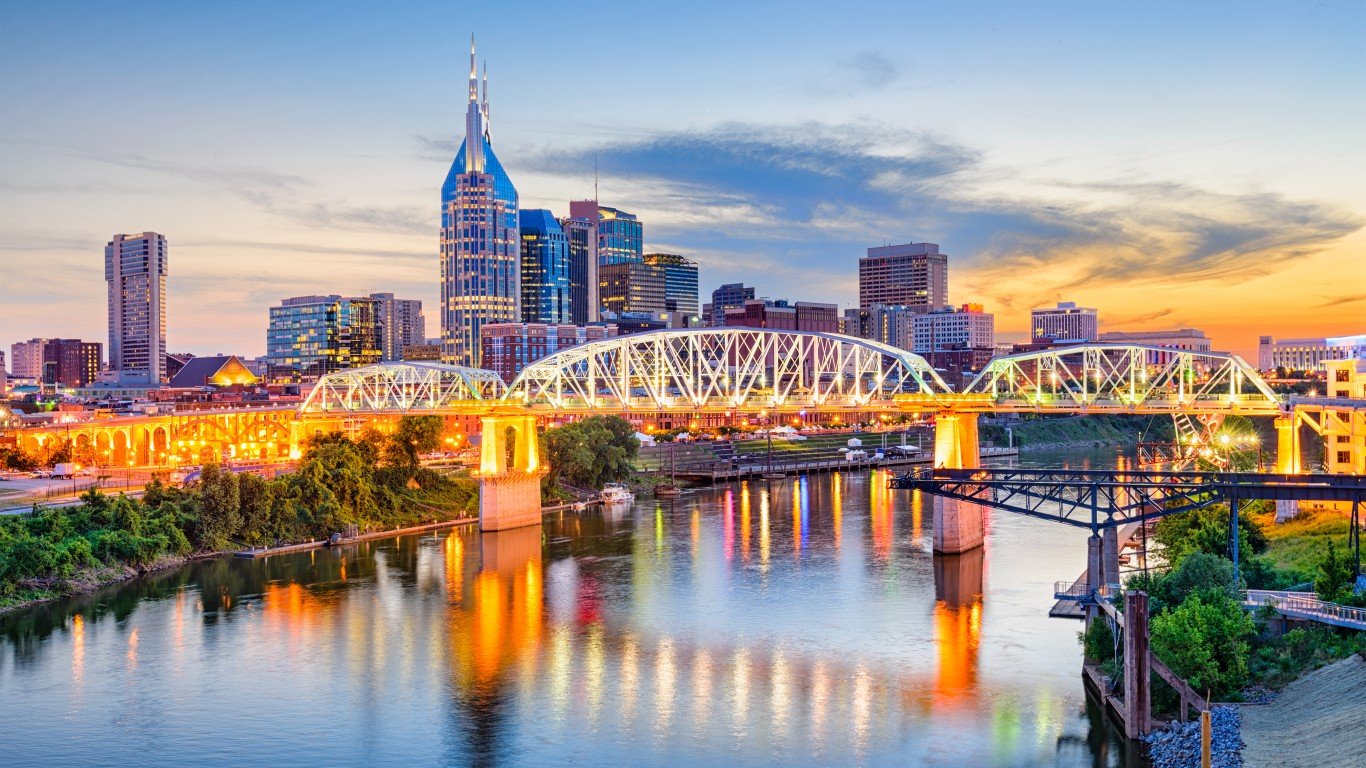
41. Nashville-Davidson-Murfreesboro-Franklin, TN
> Violent crime rate: 616 per 100,000 people (12,137 total crimes)
> 1-yr. change in violent crime rate: +8.0%
> Homicide rate: 7.7 per 100,000 people (152 total homicides)
> Poverty rate: N/A
Up 8% from 2019, the violent crime rate in the Nashville, Tennessee, metro area stands at 616 incidents per 100,000 people — well above the national rate. The increase in violent crime in the Nashville area was led by homicides, which surged by nearly 29% year over year.
Rising rates of deadly violence have continued well into 2021 in Nashville. As of early July, 68 homicides were committed in the city proper, up from 43 at the same point in 2020 and 30 the previous year.
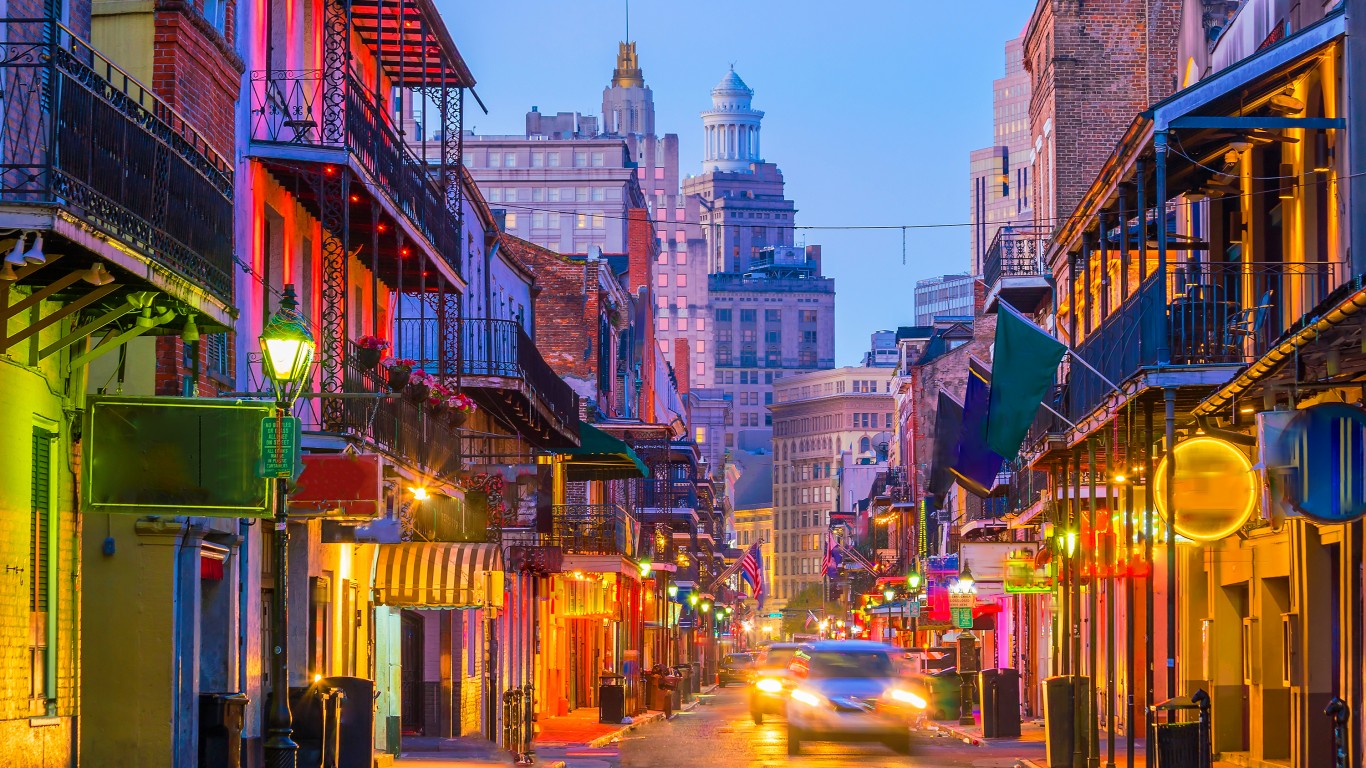
40. New Orleans-Metairie, LA
> Violent crime rate: 624 per 100,000 people (7,960 total crimes)
> 1-yr. change in violent crime rate: +13.2%
> Homicide rate: 21.7 per 100,000 people (277 total homicides)
> Poverty rate: 16.4%
The violent crime rate in the New Orleans metro area of 624 incidents for every 100,000 people is among the highest in the nation. The local violent crime rate climbed by 13.2% last year, more than double the national increase. The homicide rate is especially high in the area. There were 277 murders in New Orleans in 2020, or 21.7 for every 100,000 people, fourth highest among U.S. metro areas and more than triple the national homicide rate.
While violence is on the rise in New Orleans, property crimes are becoming less common. Cases of burglary have fallen by 11.8% in the metro area in 2020, and larceny theft cases declined by 16.1%.
[in-text-ad]
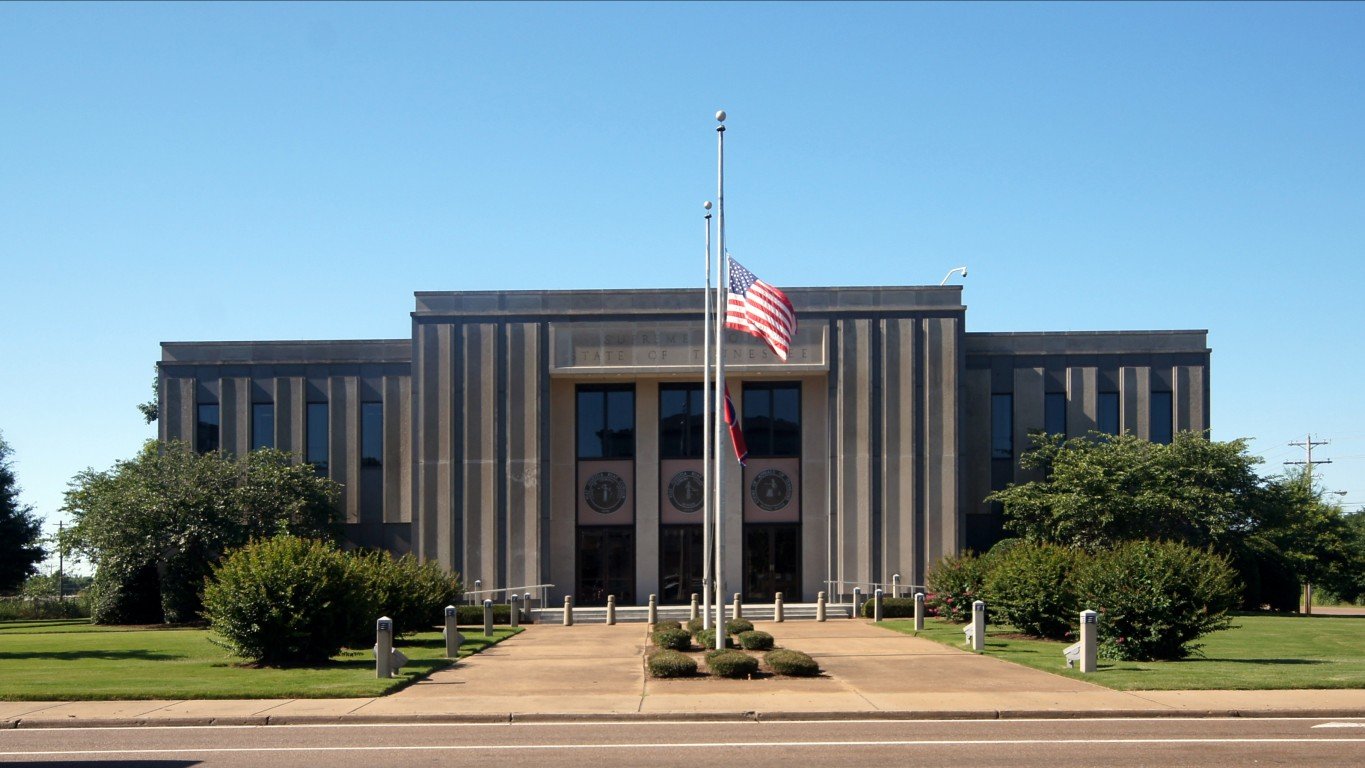
39. Jackson, TN
> Violent crime rate: 625 per 100,000 people (1,115 total crimes)
> 1-yr. change in violent crime rate: +1.8%
> Homicide rate: 9.5 per 100,000 people (17 total homicides)
> Poverty rate: 16.0%
Jackson is the second most dangerous metro area in Tennessee and one of the most dangerous nationwide. A total of 1,115 violent crimes were reported in the metro area in 2020, or 625 for every 100,000 people. Though cases of rаpe, robbery, and homicide declined in 2020, aggravated assault cases increased, resulting in a 1.8% year-over-year overall uptick in the local violent crime rate.
In the early months of 2021, gang violence has been on the rise in Jackson, as have drug-related crimes. In an attempt to reverse the trend, the Jackson Police Department is reinstating its Blue Impact Program, which among other tactics, uses community policing — a strategy based on public-facing events designed to develop trust between police and community members.

38. Billings, MT
> Violent crime rate: 627 per 100,000 people (1,152 total crimes)
> 1-yr. change in violent crime rate: N/A
> Homicide rate: 8.2 per 100,000 people (15 total homicides)
> Poverty rate: 11.7%
There were 1,152 violent crimes reported in the Billings, Montana, metro area in 2020, or 627 for every 100,000 people. Like much of the country, the area is suffering from a surge in violence. According to the Billings Police Department, domestic violence calls increased by 25% in 2020 and assaults on police officers and assaults with a weapon each increased by 50%.
In response to the rising violence, Billings residents passed a ballot initiative in November 2021 that will allocate $7.1 million to address the rising rates of violence. That money is in addition to the extra $5 million allocated to public safety in 2020.

37. Springfield, MO
> Violent crime rate: 632 per 100,000 people (2,993 total crimes)
> 1-yr. change in violent crime rate: -0.2%
> Homicide rate: 5.5 per 100,000 people (26 total homicides)
> Poverty rate: 15.4%
Springfield is the only metro area in Missouri to rank among the 50 most dangerous cities in the United States. There were 2,993 violent crimes reported in Springfield in 2020, or 632 for every 100,000 people. Though the metro area’s overall violent crime rate declined slightly in 2020, the reported number of homicides soared by over 50% — from 17 in 2019 to 26 in 2020.
Crime in the United States is often disproportionately concentrated in poor communities, and in Springfield, 15.4% of the population live below the poverty line, compared to 12.3% of the U.S. population.
[in-text-ad-2]
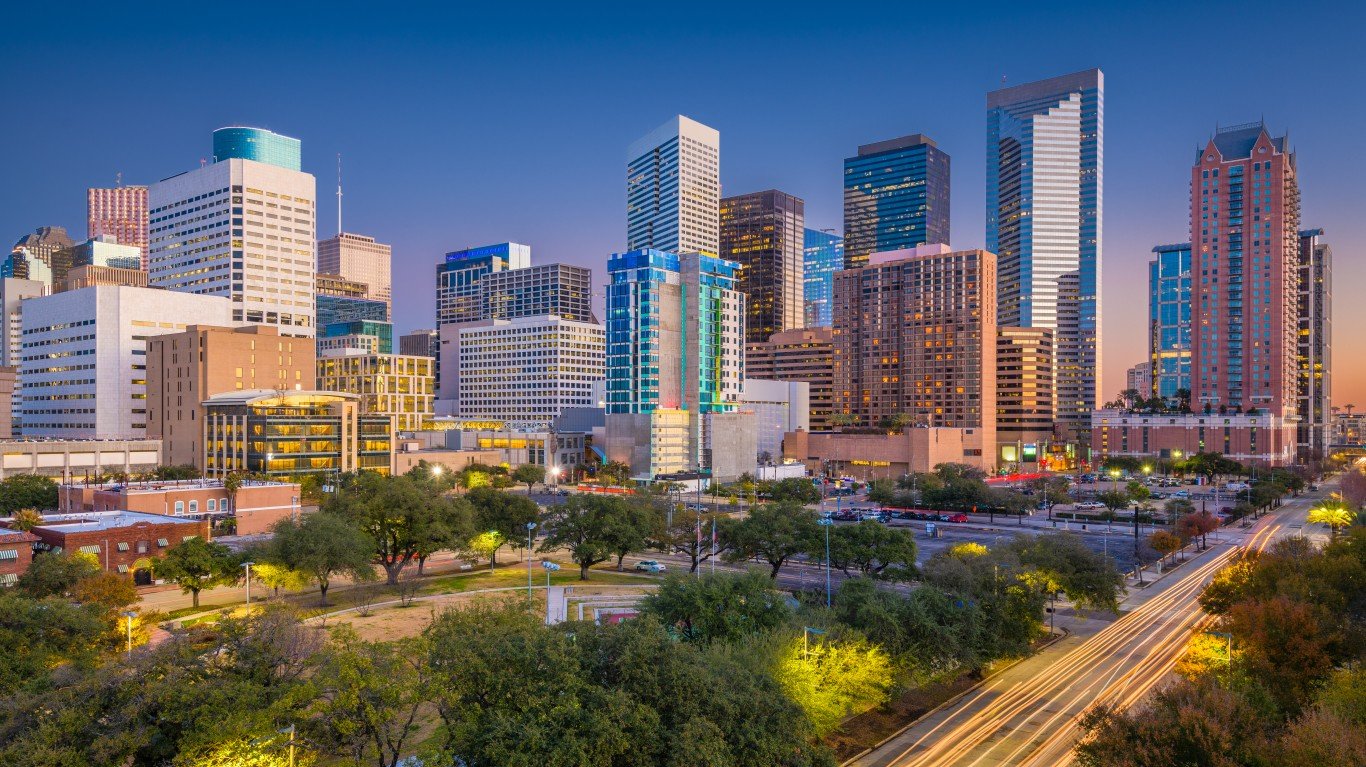
36. Houston-The Woodlands-Sugar Land, TX
> Violent crime rate: 632 per 100,000 people (45,368 total crimes)
> 1-yr. change in violent crime rate: N/A
> Homicide rate: 9.2 per 100,000 people (662 total homicides)
> Poverty rate: 12.9%
There were 45,368 violent crimes committed in Houston — one of the largest metro areas in the country — last year. Even after adjusting for its large population, the local violent crime rate is higher than in most of the rest of the country, at 632 incidents per 100,000 people. The metro area’s robbery rate of 168 incidents for every 100,000 people is particularly high, ranking in the top 10 metros for robberies.
Violence in Houston has continued to increase in 2021. Homicides in the city are up 29% so far this year compared to the same period last year. Firearms are a common factor in many violent crimes across the metro area.
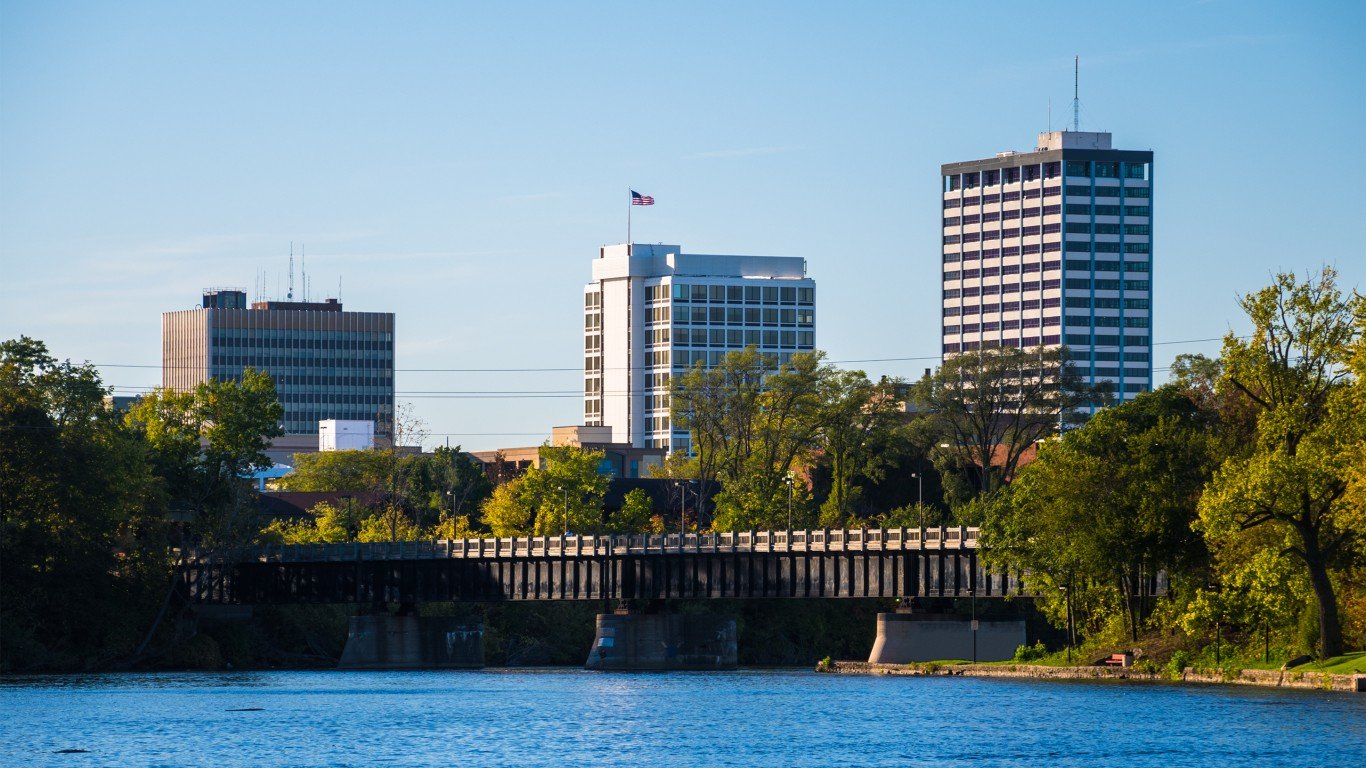
35. South Bend-Mishawaka, IN-MI
> Violent crime rate: 655 per 100,000 people (2,121 total crimes)
> 1-yr. change in violent crime rate: N/A
> Homicide rate: 9.3 per 100,000 people (30 total homicides)
> Poverty rate: 15.9%
South Bend is the most dangerous metro area in Indiana and one of the most dangerous nationwide. There were 2,121 violent crimes reported in South Bend in 2020, or 655 for every 100,000 people.
In a State of the City address earlier this year, South Bend Mayor James Mueller acknowledged the rising rates of violence in the city during the pandemic and called for residents to work together to reduce crime committed — often with firearms — by local youth. There were 133 shooting victims in South Bend proper in the first seven months of 2021 alone.
[in-text-ad]
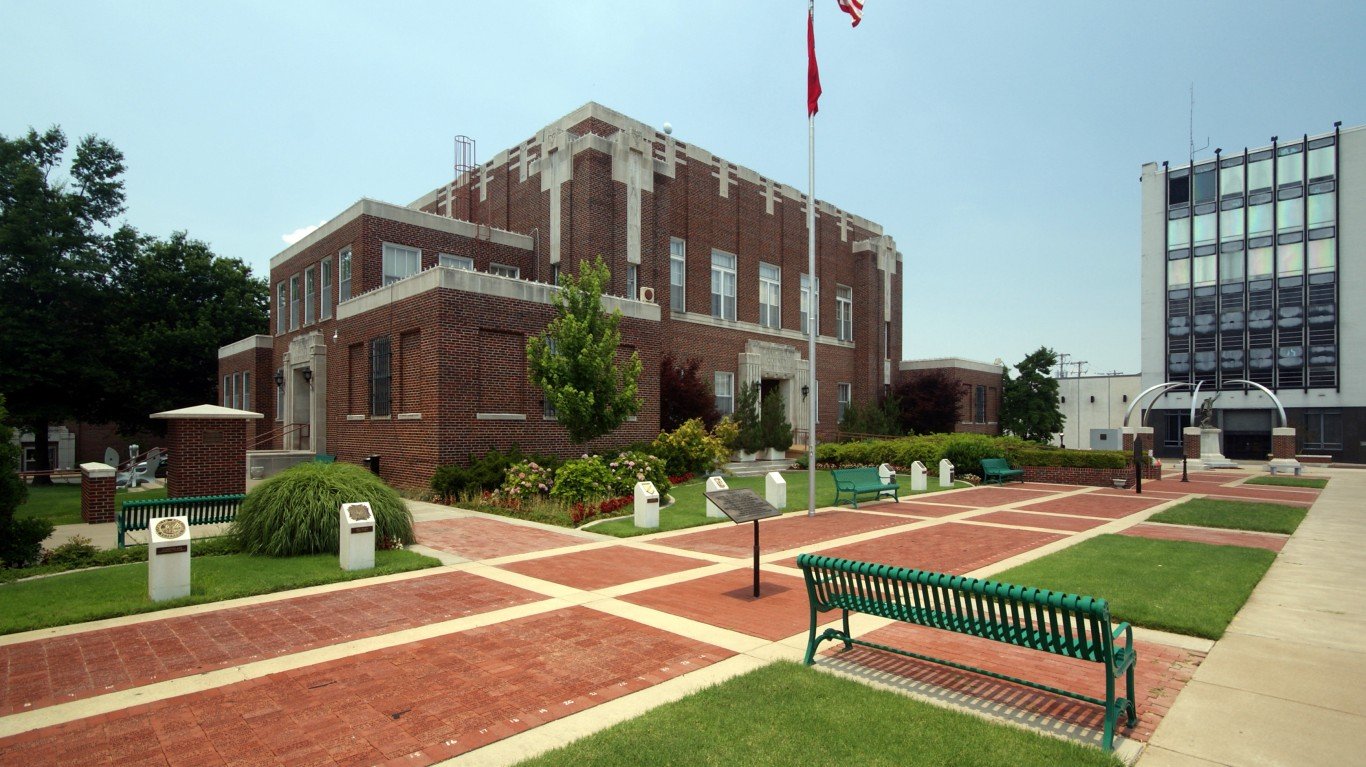
34. Jonesboro, AR
> Violent crime rate: 660 per 100,000 people (893 total crimes)
> 1-yr. change in violent crime rate: +18.6%
> Homicide rate: 9.6 per 100,000 people (13 total homicides)
> Poverty rate: 18.9%
Over half of the 50 most dangerous U.S. metro areas are in the South with five are in Arkansas alone — and Jonesboro is one of them. After jumping 18.6% year over year, Jonesboro’s violent crime rate stands at 660 incidents for every 100,000 people. The increase was driven by a surge in cases of aggravated assault.
Crime in the United States is often disproportionately concentrated in poor communities, and in Jonesboro, 18.9% of the population live below the poverty line, compared to 12.3% of the U.S. population.
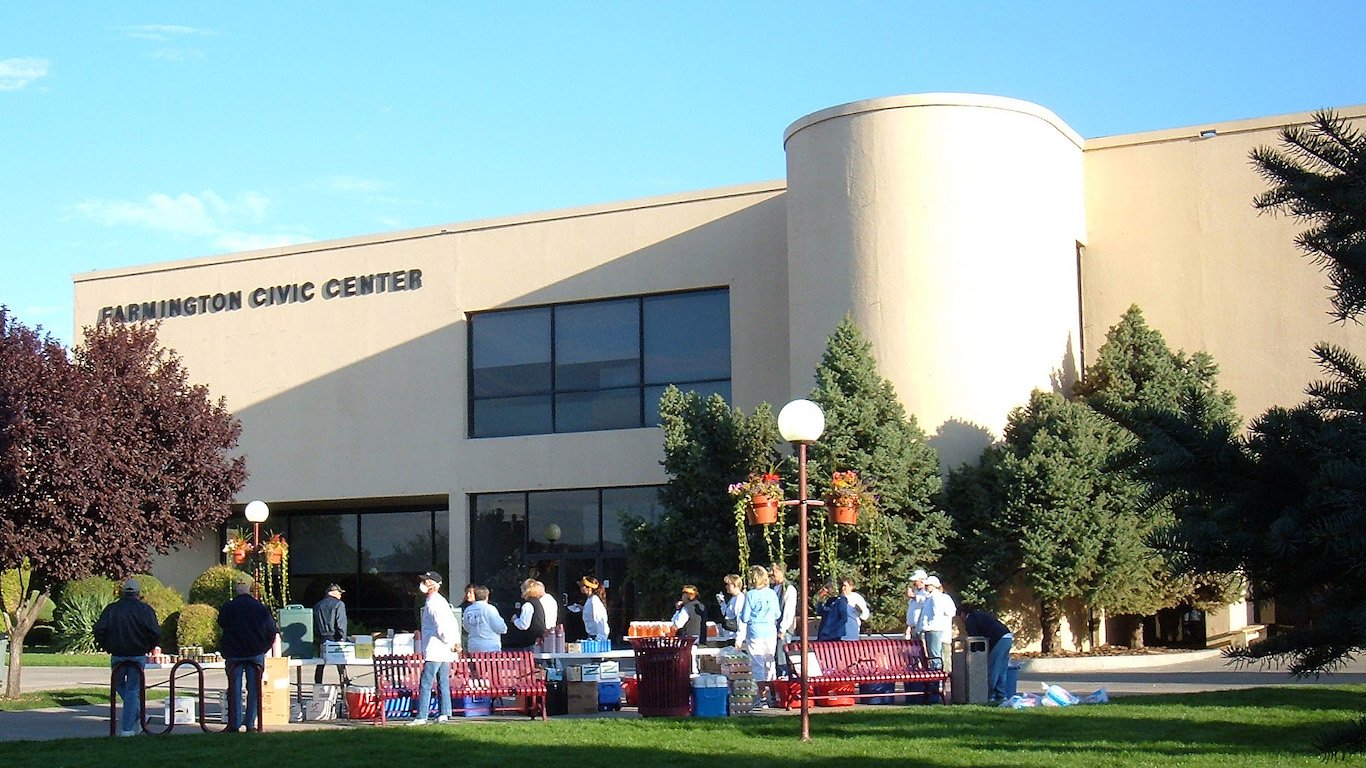
33. Farmington, NM
> Violent crime rate: 661 per 100,000 people (817 total crimes)
> 1-yr. change in violent crime rate: N/A
> Homicide rate: 3.2 per 100,000 people (4 total homicides)
> Poverty rate: 21.2%
Farmington, New Mexico, is one of only 10 metro areas located in a Western state to rank among the 50 most dangerous metro areas in the country. There were 817 violent crimes reported in Farmington in 2020, or 661 for every 100,000 people.
Rates of violence are often higher in places with limited economic opportunity — and in Farmington, 21.2% of the population live below the poverty line, and average unemployment in 2020 was 10.0%. This compares to the national 12.3% poverty rate and 8.1% jobless rate that year.

32. Kalamazoo-Portage, MI
> Violent crime rate: 663 per 100,000 people (1,763 total crimes)
> 1-yr. change in violent crime rate: +15.9%
> Homicide rate: 7.5 per 100,000 people (20 total homicides)
> Poverty rate: 13.4%
After jumping 15.9% year over year, the violent crime rate in the Kalamazoo-Portage, Michigan, metro area stands at 663 incidents for every 100,000 people. The increase was driven by a 33% surge in aggravated assault cases and a 67% spike in homicide cases.
Rising rates of gun violence are contributing to the trend. All but one of the homicides reported in Kalamazoo proper were carried out with a firearm, and the number of non-fatal shootings in the city doubled from 2019 to 2020. Gun violence shows no signs of slowing as shootings year to date are higher in 2021 than they were in 2020.
[in-text-ad-2]
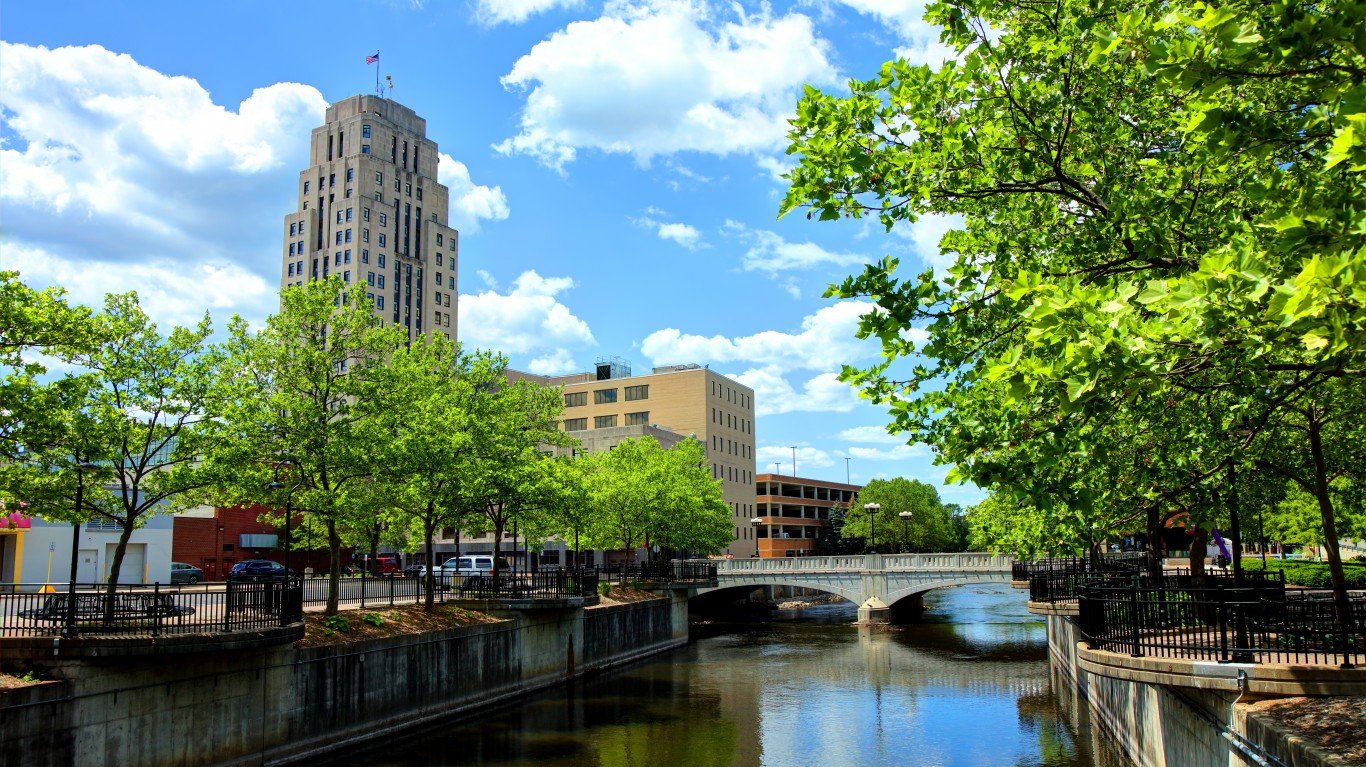
31. Battle Creek, MI
> Violent crime rate: 664 per 100,000 people (886 total crimes)
> 1-yr. change in violent crime rate: +6.3%
> Homicide rate: 10.5 per 100,000 people (14 total homicides)
> Poverty rate: 13.4%
Battle Creek is one of five Michigan metro areas to rank among the 50 most dangerous U.S. cities. There were 886 violent crimes reported in the metro area in 2020, or 664 for every 100,000 people. Homicides in Battle Creek more than doubled year over year, from six in 2019 to 14 in 2020.
Rates of violence are often higher in places with limited economic opportunity — and in Battle Creek, 13.4% of the population live below the poverty line and average unemployment in 2020 was 9.7%. This compares to the national 12.3% poverty rate and 8.1% jobless rate that year.
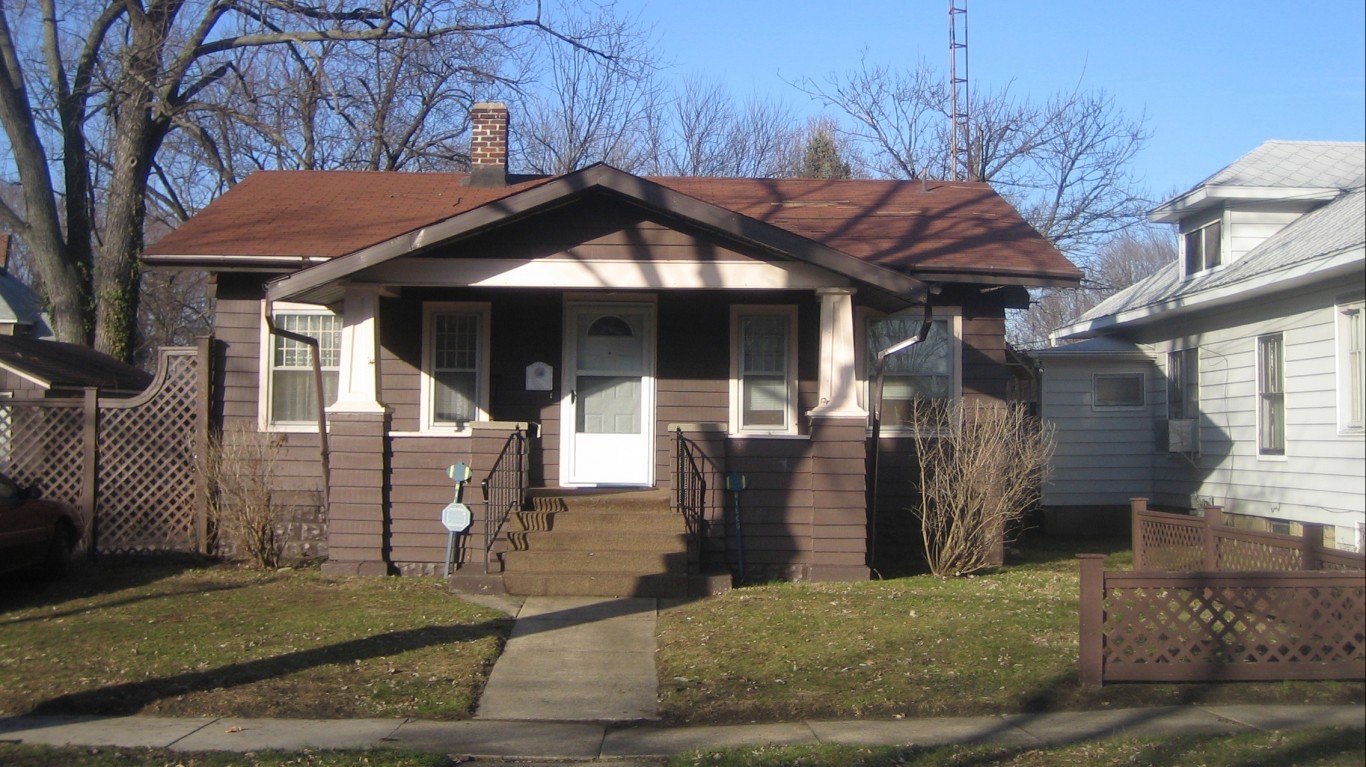
30. Niles, MI
> Violent crime rate: 664 per 100,000 people (1,013 total crimes)
> 1-yr. change in violent crime rate: +20.6%
> Homicide rate: 5.2 per 100,000 people (8 total homicides)
> Poverty rate: 16.2%
After jumping 20.6% year over year, the violent crime rate in the Niles, Michigan, metro area stands at 664 incidents for every 100,000 people — higher than in the vast majority of U.S. metro areas. The increase was driven by a 38% surge in cases of aggravated assault and a 60% spike in homicide cases.
As is often the case in metro areas with high rates of criminal violence, Niles is home to a disproportionately large share of residents facing severe financial hardship. The local poverty rate of 16.2% is considerably higher than the comparable 12.3% national rate.
[in-text-ad]
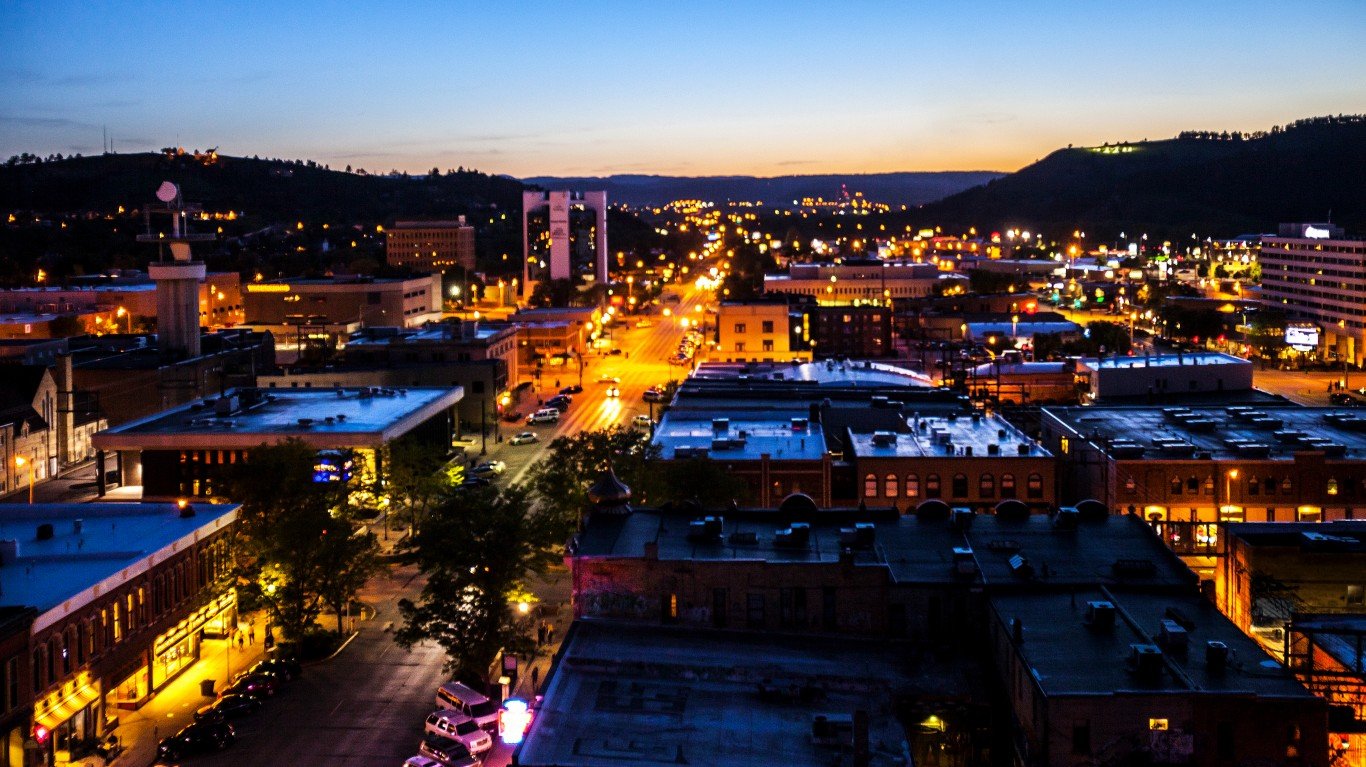
29. Rapid City, SD
> Violent crime rate: 665 per 100,000 people (957 total crimes)
> 1-yr. change in violent crime rate: +25.0%
> Homicide rate: 10.4 per 100,000 people (15 total homicides)
> Poverty rate: 11.0%
Rapid City is the only metro area in South Dakota, and one of 13 in the Midwest, to rank among the 50 most dangerous U.S. cities. There were 957 violent crimes reported in Rapid City in 2020, or 665 for every 100,000 people — a 25% increase from the previous year.
While reports of every category of violent crime increased in Rapid City in 2020, none climbed more than homicide. A total of 15 murders were committed in the metro area last year, triple the reported number in 2019.
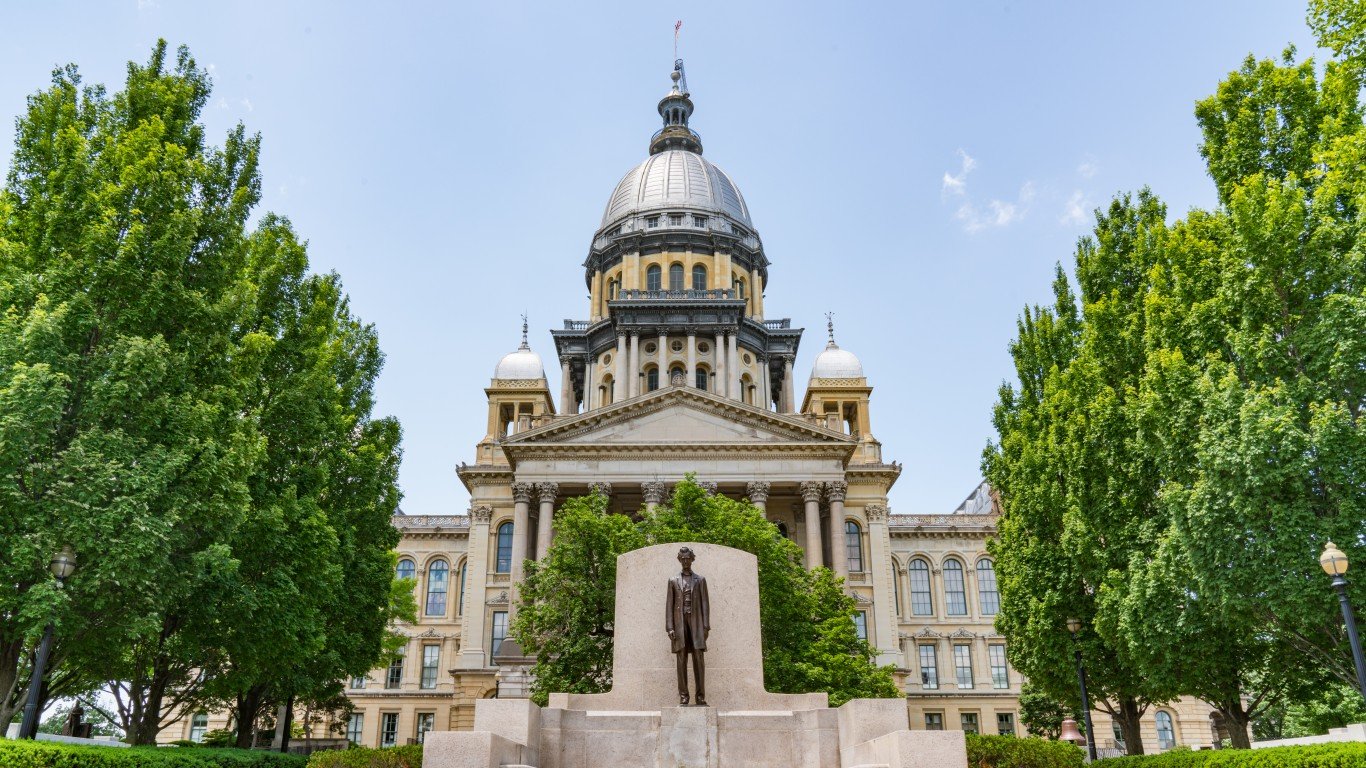
28. Springfield, IL
> Violent crime rate: 667 per 100,000 people (1,369 total crimes)
> 1-yr. change in violent crime rate: +14.1%
> Homicide rate: 5.8 per 100,000 people (12 total homicides)
> Poverty rate: 12.2%
There were 1,369 violent crimes reported in the Springfield, Illinois, metro area in 2020, or 667 for every 100,000 people. Like much of the country, Springfield is suffering from a surge in violence. Though reported cases of rаpe and robbery declined in the area year over year, homicides climbed by 20% and cases of aggravated assault surged by nearly 25%.
Springfield is one of three metro areas in Illinois to rank among the 50 most dangerous U.S. cities. In early November 2021, Gov. JB Pritzker signed an executive order classifying the gun violence afflicting much of the state as a public health emergency. The creation of the Office of Firearm Violence Prevention, tasked with coordinating efforts to prevent violence, is one of the measures the executive order will implement.
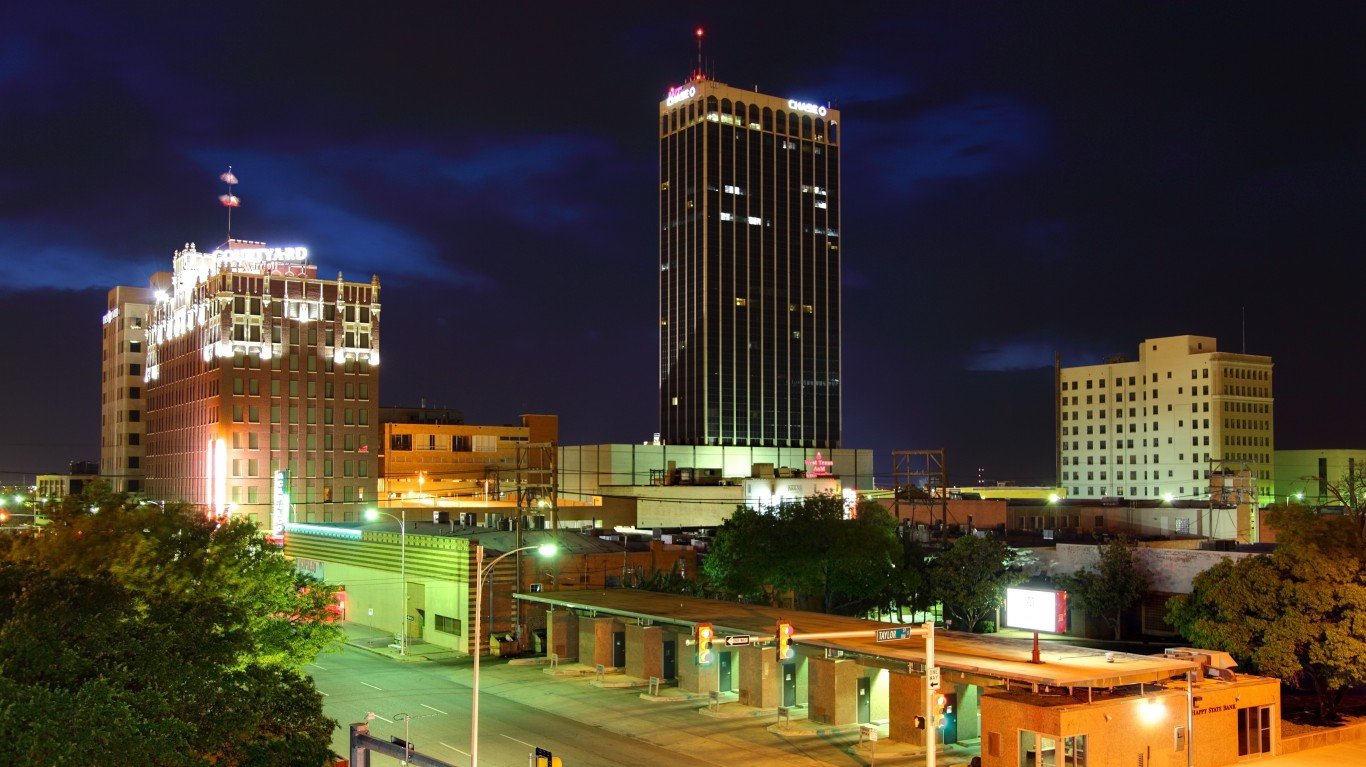
27. Amarillo, TX
> Violent crime rate: 673 per 100,000 people (1,787 total crimes)
> 1-yr. change in violent crime rate: +13.0%
> Homicide rate: 6.8 per 100,000 people (18 total homicides)
> Poverty rate: 14.4%
There were 1,787 violent crimes reported in the Amarillo, Texas, metro area in 2020, or 673 for every 100,000 people. Like much of the country, Amarillo is suffering from a surge in violence. Though reported cases of rаpe and robbery declined in the area year over year, homicides climbed by 12.5% and cases of aggravated assault surged by 21%. As a result, the overall violent crime rate climbed 13% year over year.
Rising rates of violence have continued into 2021 in Amarillo. City police report an uptick in gun violence — often involving stolen firearms — and homicide.
[in-text-ad-2]
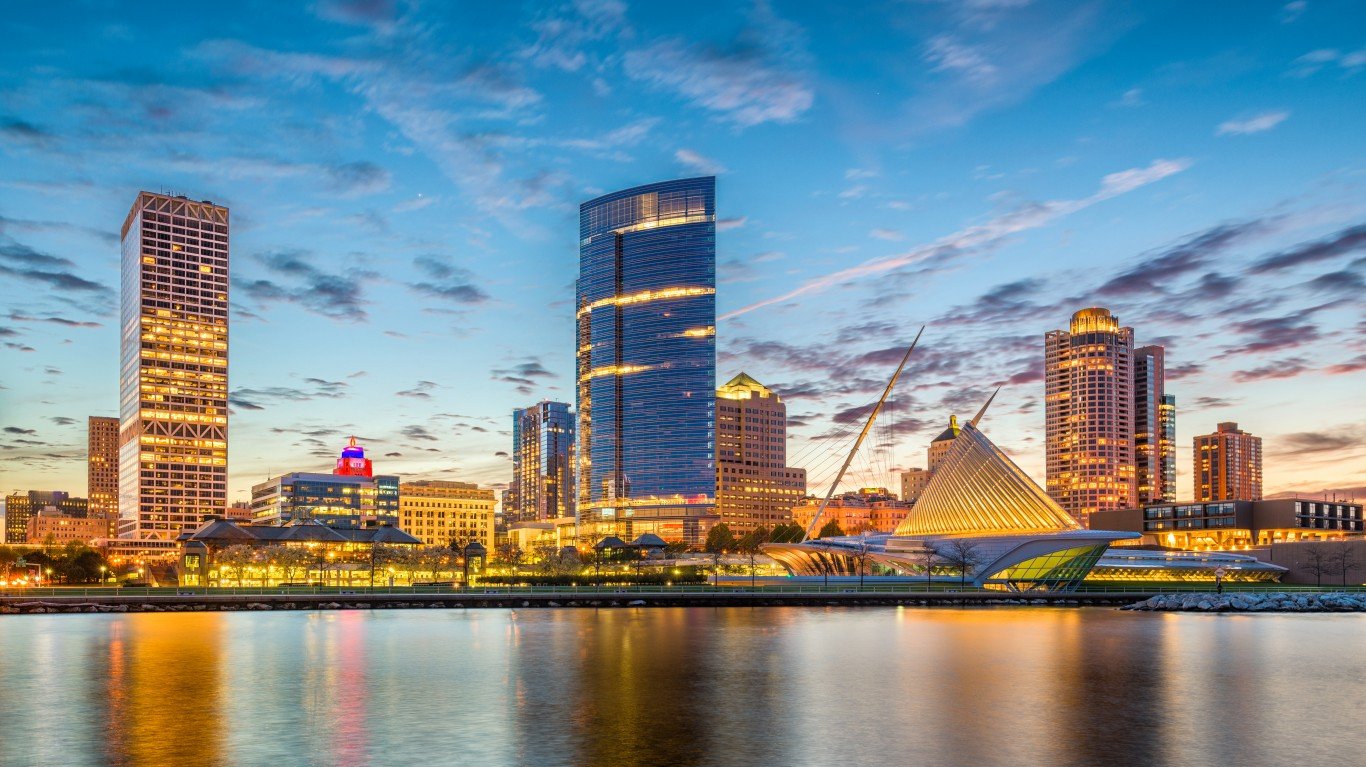
26. Milwaukee-Waukesha, WI
> Violent crime rate: 678 per 100,000 people (10,688 total crimes)
> 1-yr. change in violent crime rate: +17.4%
> Homicide rate: 13.1 per 100,000 people (206 total homicides)
> Poverty rate: 11.8%
Milwaukee-Waukesha is the only metro area in Wisconsin to rank among the 50 most dangerous U.S. cities. After jumping 17.4% year over year, the violent crime rate in the metro area stands at 678 incidents for every 100,000 people — higher than in the vast majority of U.S. metro areas. The increase was led by an 86% surge in homicides, from 111 in 2019 to 206 in 2020.
The majority of homicides in Milwaukee proper in 2020 were committed in an area that, due to redlining and other racist housing policies, is both poor and predominantly Black. Some local officials connect the rising violence in the area to an influx of firearms and increased tensions between police and the communities they serve.
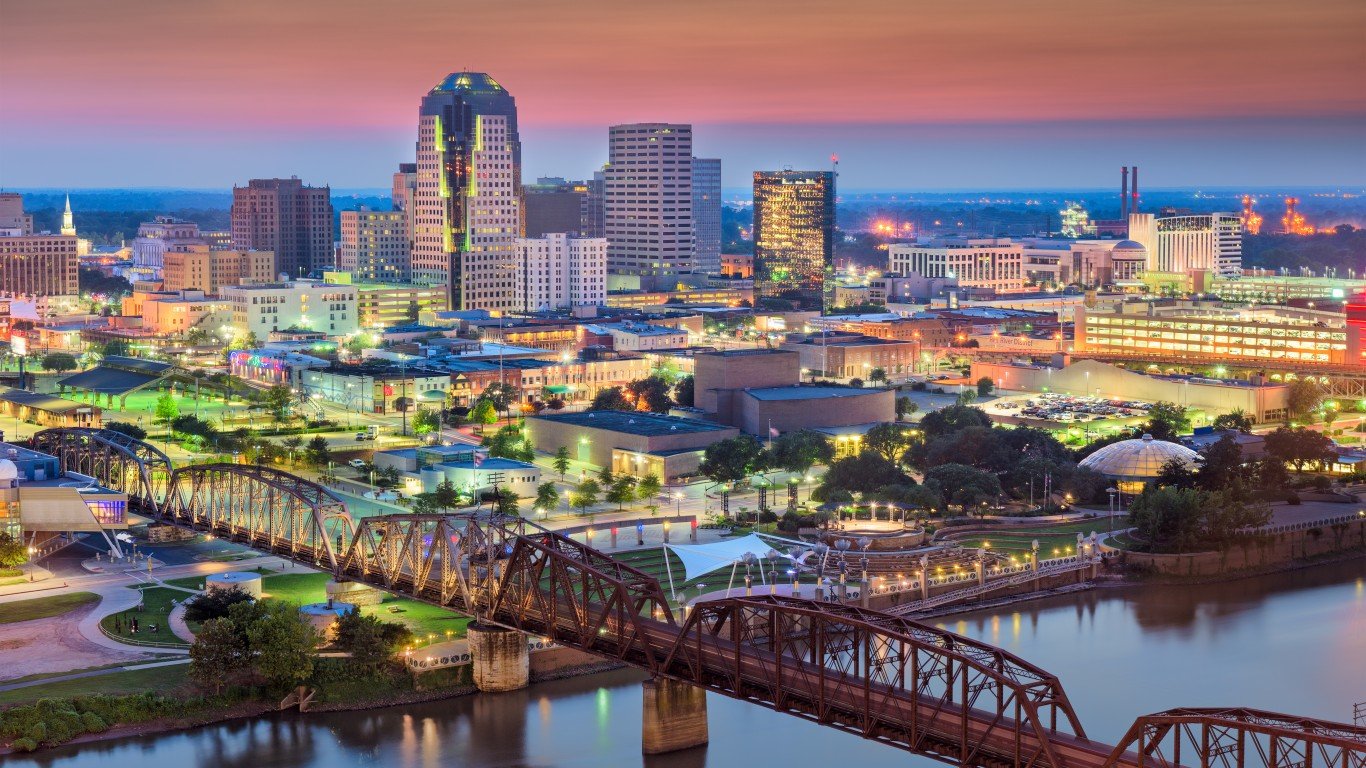
25. Shreveport-Bossier City, LA
> Violent crime rate: 683 per 100,000 people (2,683 total crimes)
> 1-yr. change in violent crime rate: +21.3%
> Homicide rate: 21.6 per 100,000 people (85 total homicides)
> Poverty rate: 22.2%
Following a 21.3% spike, the violent crime rate in the Shreveport-Bossier City, Louisiana, metro area stands at 683 per 100,000 — higher than in the vast majority of U.S. metropolitan areas. The increase was led by homicides, which more than doubled from 41 in 2019 to 85 in 2020.
Deadly violence in the area has continued to surge into 2021, prompting Shreveport’s chief of police to step down following a vote of no confidence from the city council. Local experts claim that the pandemic has exacerbated existing socioeconomic problems, like poverty, that are linked to crime. An estimated 22.2% of metro area residents live below the poverty line, compared to 12.3% of all Americans.
[in-text-ad]
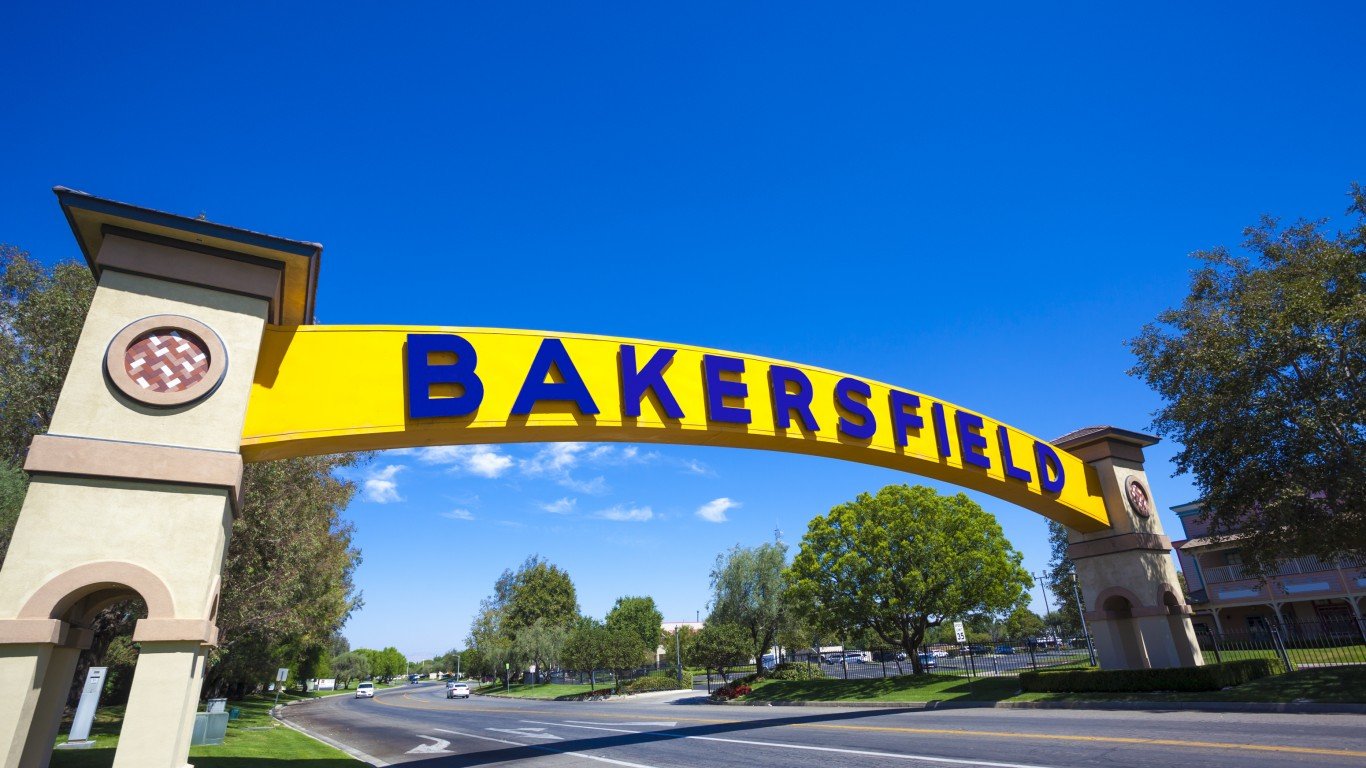
24. Bakersfield, CA
> Violent crime rate: 692 per 100,000 people (6,216 total crimes)
> 1-yr. change in violent crime rate: +11.5%
> Homicide rate: 12.9 per 100,000 people (116 total homicides)
> Poverty rate: 19.1%
There were 6,216 violent crimes reported in the Bakersfield, California, metro area in 2020, or 692 for every 100,000 people. Like much of the country, Bakersfield is suffering from a surge in violence. Though reported cases of rаpe and robbery declined in the area year over year, aggravated assault cases climbed by 20.8% and homicides surged by 38.1%. As a result, the overall violent crime rate climbed 11.5% year over year.
Local police officials attribute high and rising crime, in part, to a statewide reduction in prison populations, which has resulted in the release of some violent offenders after serving less than half of their sentence.
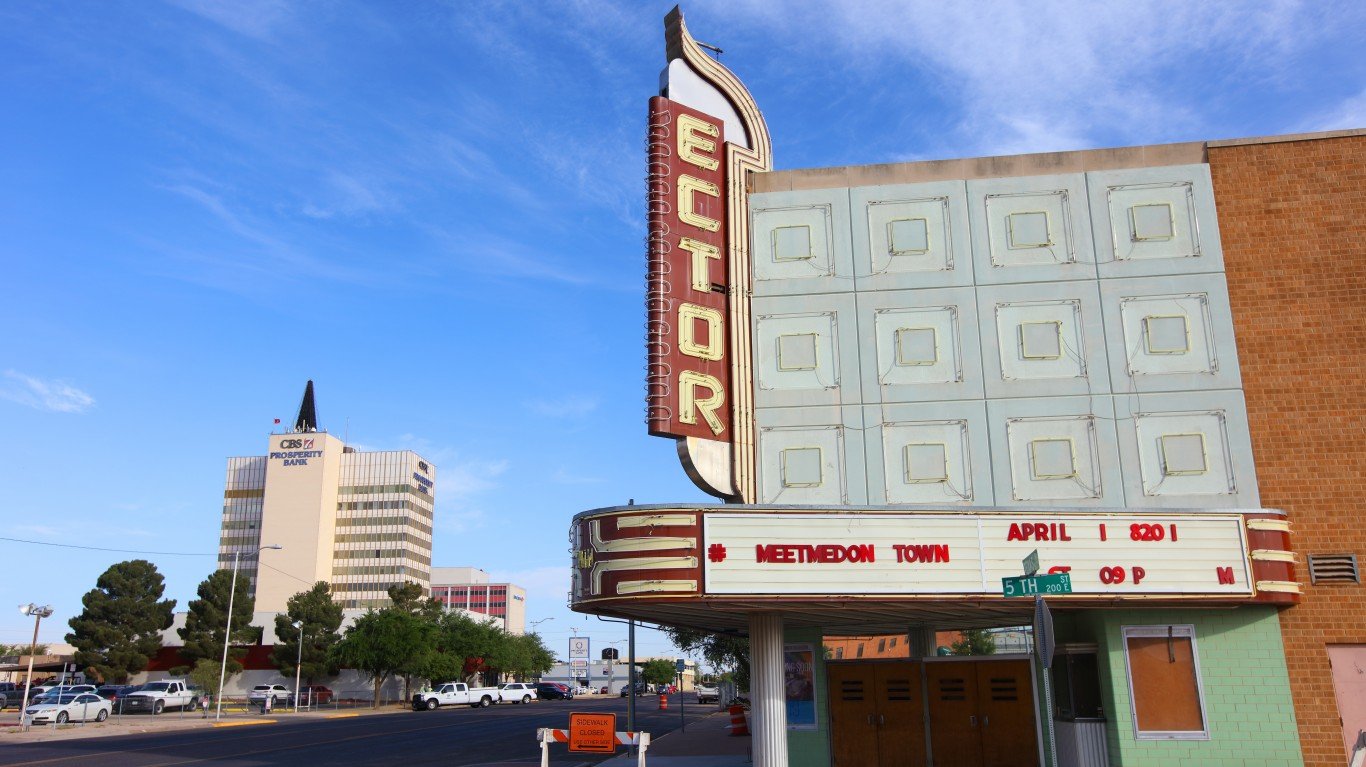
23. Odessa, TX
> Violent crime rate: 697 per 100,000 people (1,180 total crimes)
> 1-yr. change in violent crime rate: -20.9%
> Homicide rate: 11.2 per 100,000 people (19 total homicides)
> Poverty rate: 10.4%
In a break from the national trend, the violent crime rate in Odessa, Texas, fell considerably in 2020. Still, despite the 20.9% decline from the previous year, the metro area’s violent crime rate of 697 incidents for every 100,000 people is one of the highest of any U.S. metro area.
Local police confirm that crime rates have continued to decline in Odessa in 2021. To reduce violence, Odessa police have focused on getting illegal firearms off the streets.

22. Macon-Bibb County, GA
> Violent crime rate: 708 per 100,000 people (1,624 total crimes)
> 1-yr. change in violent crime rate: +55.7%
> Homicide rate: 19.2 per 100,000 people (44 total homicides)
> Poverty rate: 19.2%
The Macon-Bibb County metro area in Georgia is one of only 22 nationwide with a violent crime rate exceeding 700 incidents per 100,000 people. There were 1,624 violent crimes reported in the area in 2020, or 708 for every 100,000 people.
Like much of the country, Macon is suffering from a surge in violence. Though reported cases of robbery declined in the area year over year, aggravated assault cases surged by 91.9% and homicides more than doubled, from 21 in 2019 to 44 in 2020. As a result, the overall violent crime rate spiked 55.7% year over year.
[in-text-ad-2]
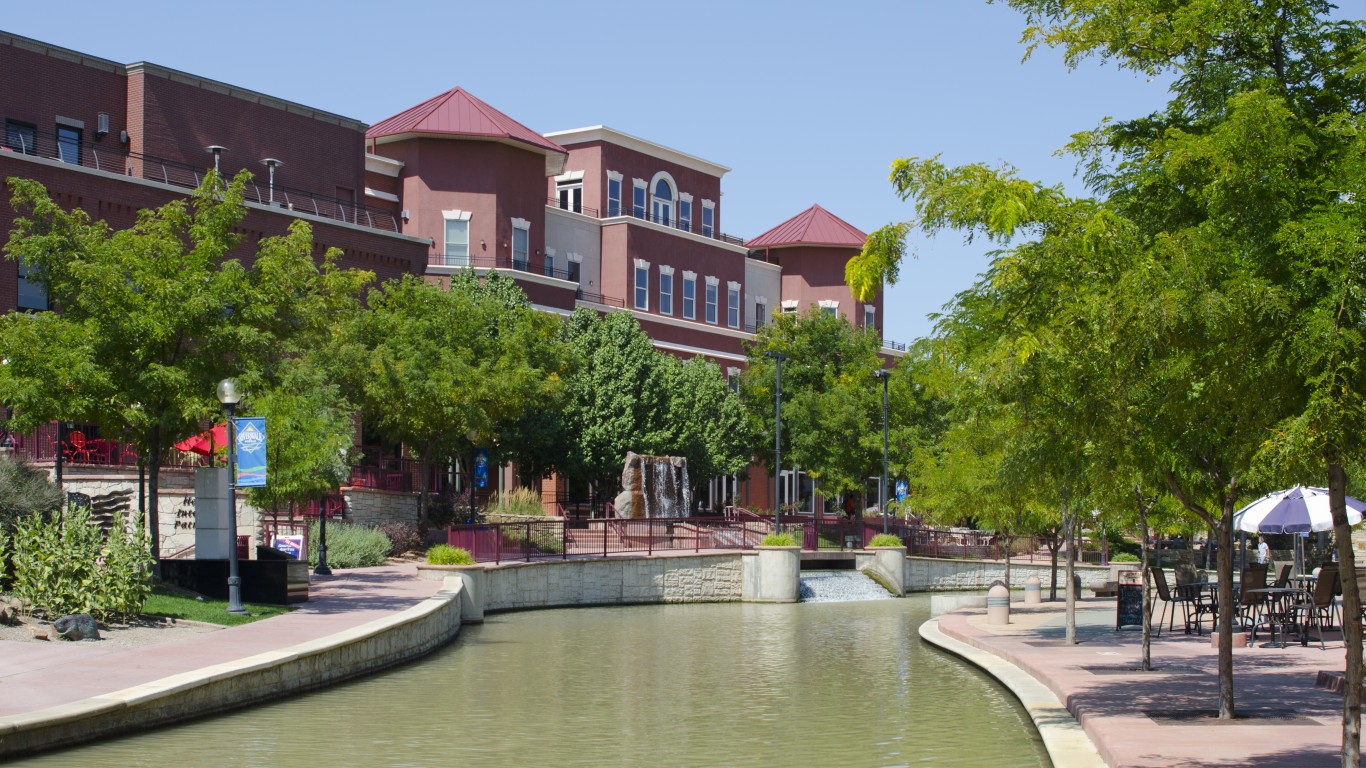
21. Pueblo, CO
> Violent crime rate: 722 per 100,000 people (1,216 total crimes)
> 1-yr. change in violent crime rate: N/A
> Homicide rate: 10.7 per 100,000 people (18 total homicides)
> Poverty rate: 17.9%
Pueblo is the only Colorado metro area — and one of only 10 in the Western U.S. — to rank among the 50 most dangerous cities in the country. There were 1,216 violent crimes reported in the area in 2020, or 722 for every 100,000 people. Violence in the Pueblo metro area is being driven by gang activity and firearms. There were over 200 shootings in the city proper in 2020 — including 161 drive-by shootings — and four gang-related homicides.
As is often the case in metro areas with high rates of criminal violence, Pueblo is home to a disproportionately large share of residents facing severe financial hardship. The local poverty rate of 17.9% is considerably higher than the comparable 12.3% national rate.

20. Stockton, CA
> Violent crime rate: 723 per 100,000 people (5,517 total crimes)
> 1-yr. change in violent crime rate: -8.3%
> Homicide rate: 11.0 per 100,000 people (84 total homicides)
> Poverty rate: 13.7%
Stockton ranks as the most dangerous metro area in California and one of the most dangerous nationwide. There were 5,517 violent crimes reported in the city in 2020, or 723 for every 100,000 people. Though the city’s overall violent crime rate fell by 8.3% last year, the number of homicides spiked. There were 84 homicides committed in Stockton in 2020, a 68% increase from 50 in 2019.
A local police spokesman attributed the increase, in part, to the COVID-19 pandemic, as there were 15 homicides resulting from domestic disputes in the city proper last year, when in normal years, there are one or two such murders. The vast majority of all homicides in Stockton last year involved firearms.
[in-text-ad]

19. Corpus Christi, TX
> Violent crime rate: 738 per 100,000 people (3,176 total crimes)
> 1-yr. change in violent crime rate: +0.1%
> Homicide rate: 10.0 per 100,000 people (43 total homicides)
> Poverty rate: 15.6%
In a break from the national trend, the violent crime rate in the Corpus Christi, Texas, metro area did not change meaningfully in 2020. Still, the metro area remains among the most dangerous in the country, with 738 violent crimes reported for every 100,000 people in 2020. The city also reported a 22.9% increase in homicides, from 35 in 2019 to 43 in 2020.
A spokesman for the Corpus Christi Police Department has said that in order to lower crime rates, law enforcement is applying for federal grants and is hiring more officers. Local officers are also engaged in community outreach to improve relations with city residents.
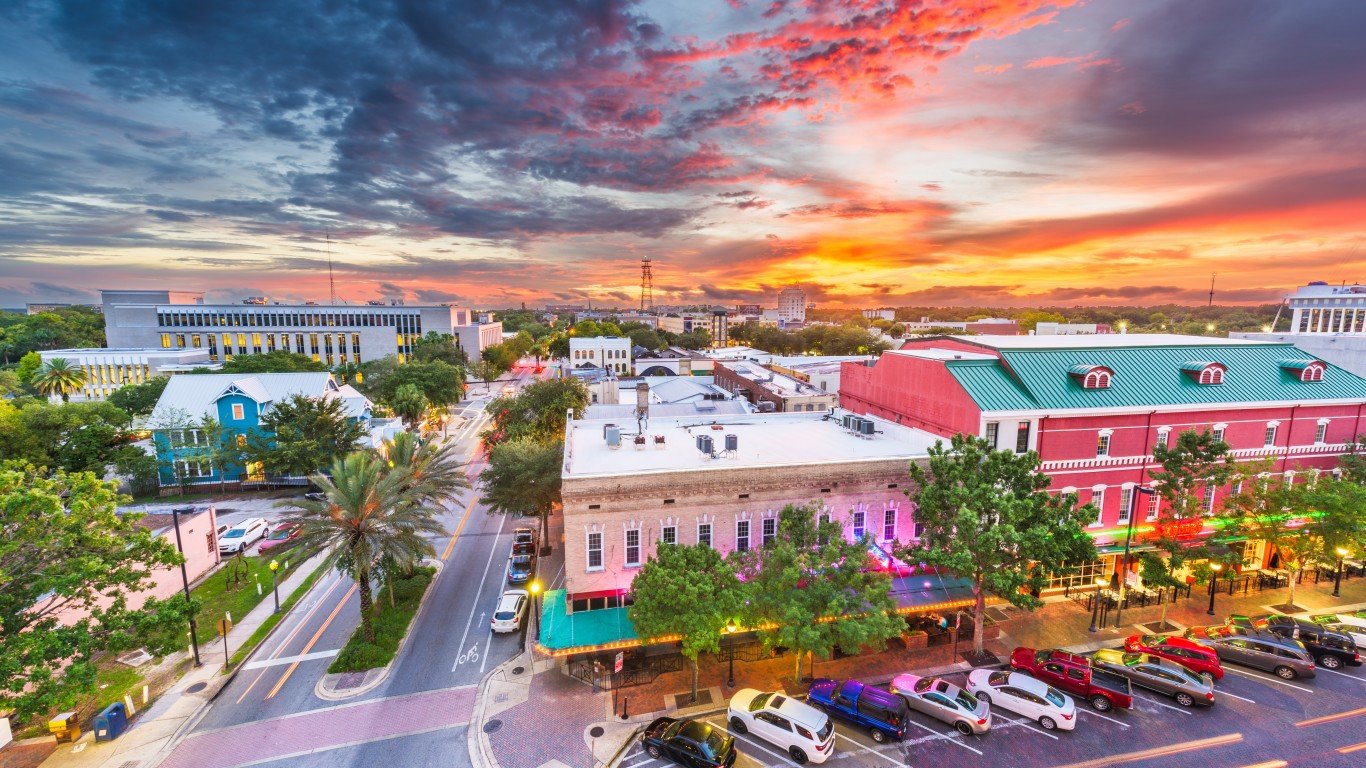
18. Gainesville, FL
> Violent crime rate: 760 per 100,000 people (2,516 total crimes)
> 1-yr. change in violent crime rate: +9.9%
> Homicide rate: 5.1 per 100,000 people (17 total homicides)
> Poverty rate: 18.5%
Following a 9.9% increase, the violent crime rate in the Gainesville, Florida, metro area stands at 760 incidents per 100,000 — higher than in the vast majority of U.S. metropolitan areas and nearly double the U.S. violent crime rate. The increase in violent crime was led by homicides, which more than doubled from seven in 2019 to 17 in 2020.
In addition to a spike in murders, Gainesville also reported an uptick in robberies and aggravated assault cases in 2020. Violence, in particular gun violence, has continued into 2021. The Gainesville Police Department received a reported 189 calls for gunfire from January through July alone.
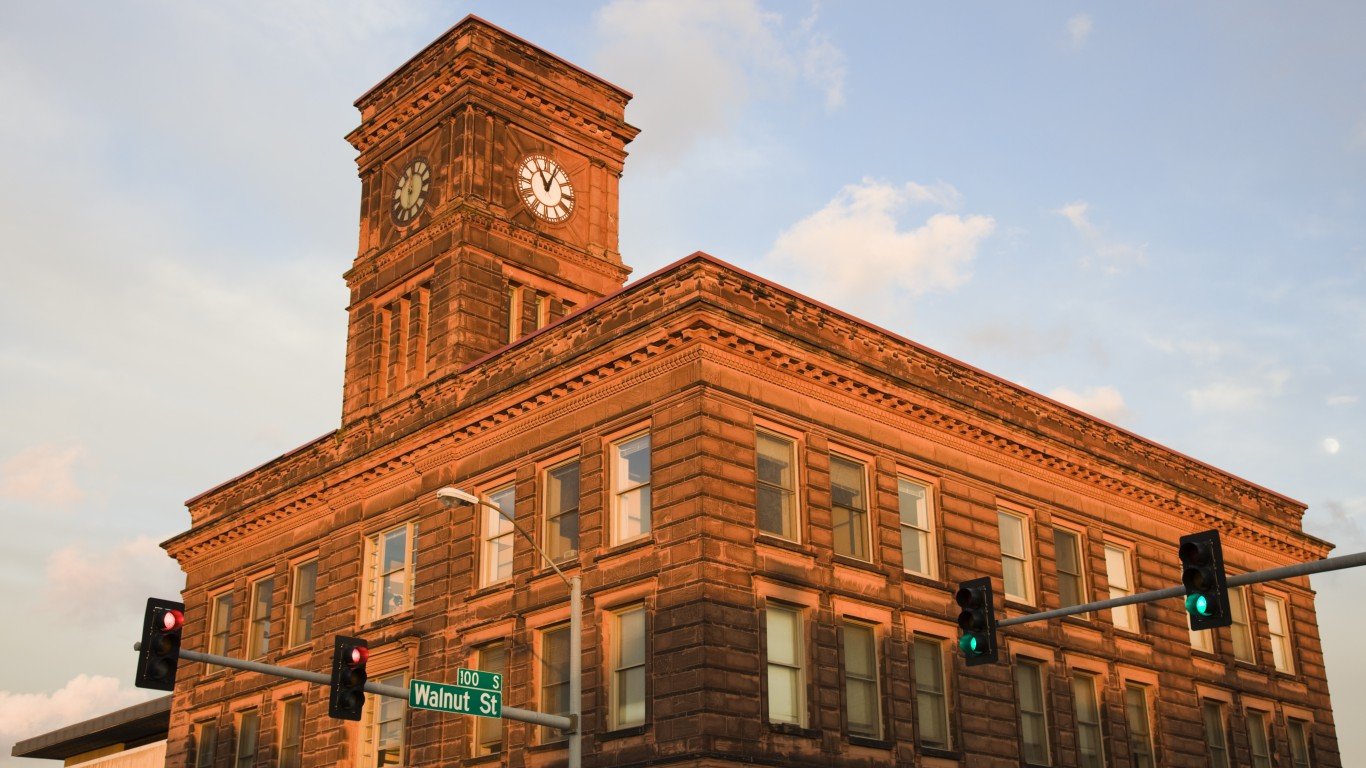
17. Rockford, IL
> Violent crime rate: 771 per 100,000 people (2,566 total crimes)
> 1-yr. change in violent crime rate: +21.5%
> Homicide rate: 10.8 per 100,000 people (36 total homicides)
> Poverty rate: 16.1%
Rockford is the second most dangerous metro area in Illinois and the fourth most dangerous in the Midwest. There were 2,566 violent crimes reported in Rockford in 2020, or 771 for every 100,000 people. Violent crimes surged in 2020, and the area’s violent crime rate is now 21.5% higher than it was in 2019.
Rising rates of violence in the metro area were led by an 80% spike in murders, from 20 in 2019 to 36 in 2020. The metro area also reported a 30% jump in cases of aggravated assault last year.
[in-text-ad-2]

16. Lake Charles, LA
> Violent crime rate: 789 per 100,000 people (1,663 total crimes)
> 1-yr. change in violent crime rate: +44.0%
> Homicide rate: 9.0 per 100,000 people (19 total homicides)
> Poverty rate: 20.4%
Lake Charles, Louisiana’s violent crime rate is nearly double the U.S. rate. There were 1,663 violent crimes reported in the metro area in 2020, or 789 for every 100,000 people. Due entirely to a surge in cases of aggravated assaults, Lake Charles’ violent crime rate is 44% higher now than it was in 2019.
Rates of violence are often higher in places with limited economic opportunity — and in Lake Charles, 20.4% of the population live below the poverty line, and average unemployment in 2020 was 8.9%. This compares to the national 12.3% poverty rate and 8.1% jobless rate that year.
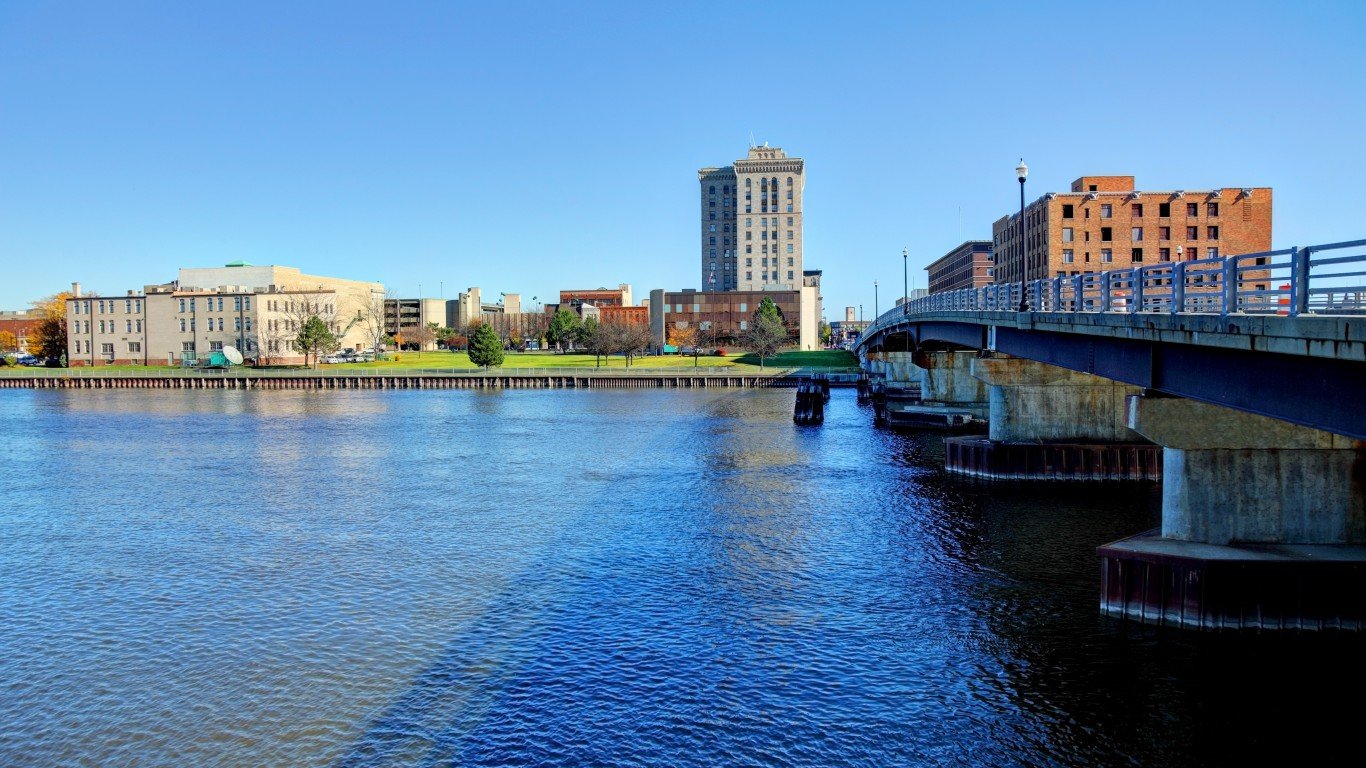
15. Saginaw, MI
> Violent crime rate: 795 per 100,000 people (1,501 total crimes)
> 1-yr. change in violent crime rate: +27.4%
> Homicide rate: 17.5 per 100,000 people (33 total homicides)
> Poverty rate: 19.0%
Of the five Michigan metro areas to rank among the 50 most dangerous cities in the country, Saginaw has the second highest violent crime rate, trailing only Detroit. After surging by 27.4% year over year, Saginaw’s violent crime rate stands at 795 incidents per 100,000 people — nearly double the national violent crime rate. At 17.5 per 100,000, the murder rate is particularly high, more than triple the national homicide rate of 6.5 per 100,000.
The surge in violence in Saginaw prompted the city council to approve a more than $250,000 expenditure on high definition cameras that will be used to identify suspected violent criminals.
[in-text-ad]

14. Sumter, SC
> Violent crime rate: 812 per 100,000 people (1,140 total crimes)
> 1-yr. change in violent crime rate: +13.0%
> Homicide rate: 19.9 per 100,000 people (28 total homicides)
> Poverty rate: 19.4%
There were 1,140 violent crimes reported in the Sumter, South Carolina, metro area in 2020, or 812 for every 100,000 people. Driven by a 16% rise in aggravated assault cases and a 65% surge in homicides, the overall violent crime rate in Sumter is 13% higher now than it was in 2019.
While violence is on the rise in Sumter, property crimes are becoming less common. Cases of motor vehicle theft have fallen by 13.1% in the metro area over the last year, burglaries were down 32.1%, and cases of larceny theft have declined by 5.5%.
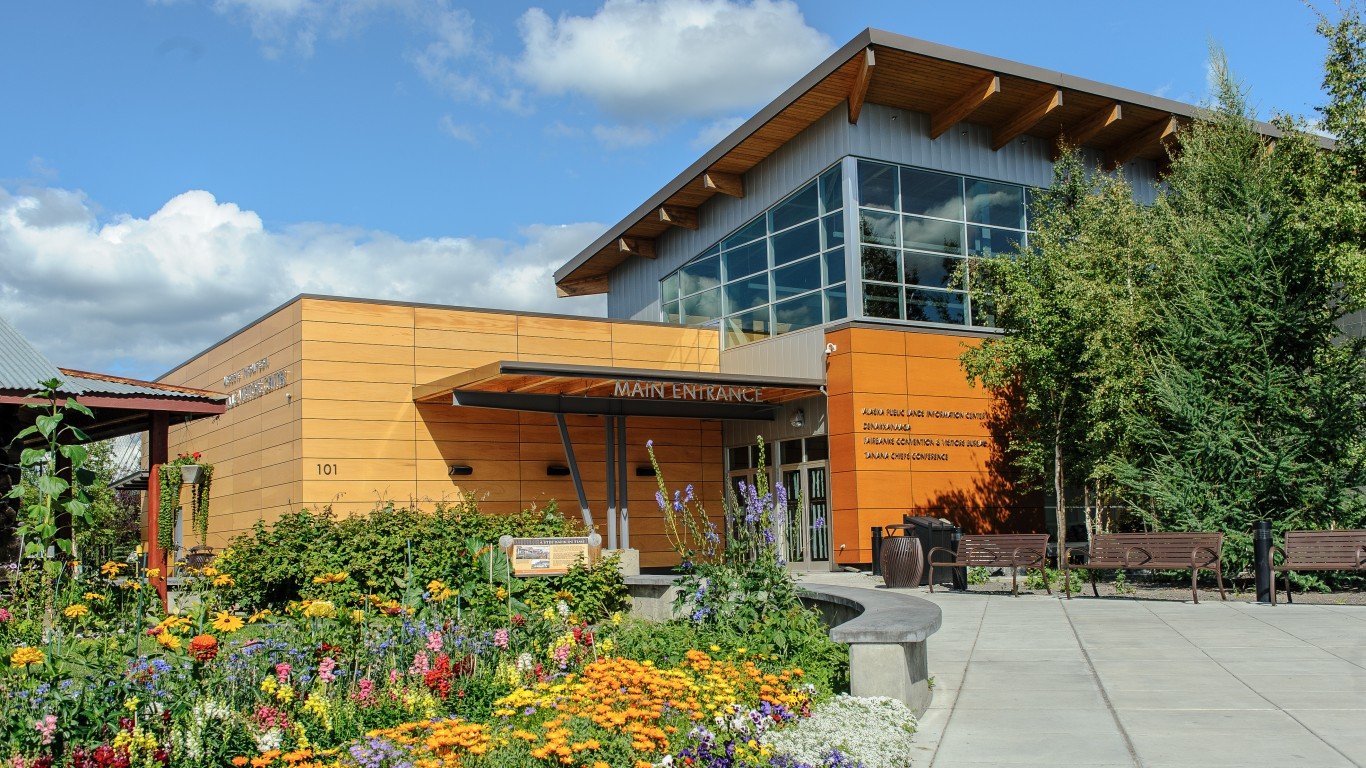
13. Fairbanks, AK
> Violent crime rate: 841 per 100,000 people (277 total crimes)
> 1-yr. change in violent crime rate: +5.9%
> Homicide rate: 9.1 per 100,000 people (3 total homicides)
> Poverty rate: 5.9%
There were 277 violent crimes reported in the Fairbanks, Alaska, metro area in 2020, or 841 for every 100,000 people — more than double the national violent crime rate. Though reported cases of robbery and rаpe declined in the metro area in 2020, aggravated assault cases climbed, contributing to a 5.9% year-over-year increase in the overall violent crime rate.
In a statewide crime reduction effort, Alaska’s Department of Public Safety is making a free crime tip app available for download. The app will allow residents to anonymously report criminal activity.
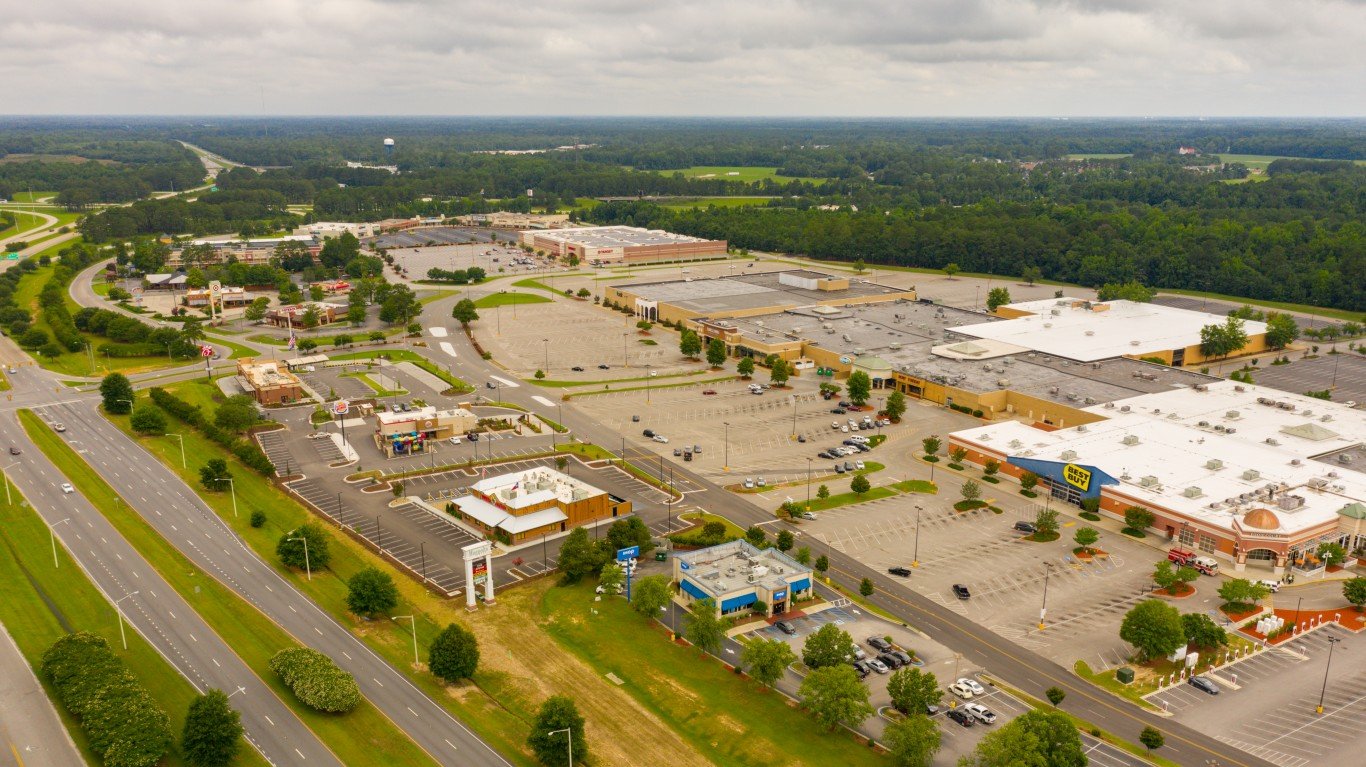
12. Florence, SC
> Violent crime rate: 860 per 100,000 people (1,764 total crimes)
> 1-yr. change in violent crime rate: +4.5%
> Homicide rate: 19.0 per 100,000 people (39 total homicides)
> Poverty rate: 16.9%
Florence ranks as the most dangerous metro area in South Carolina and one of the most dangerous nationwide. There were a total of 1,764 violent crimes reported in the metro area in 2020, or 860 for every 100,000 people. As is the case nationwide, aggravated assault cases were the most common form of criminal violence reported in the metro area last year.
While violence is on the rise in Florence, property crimes are becoming less common. Burglaries were down 29.1% last year, and cases of larceny theft have declined by 9.6%.
[in-text-ad-2]
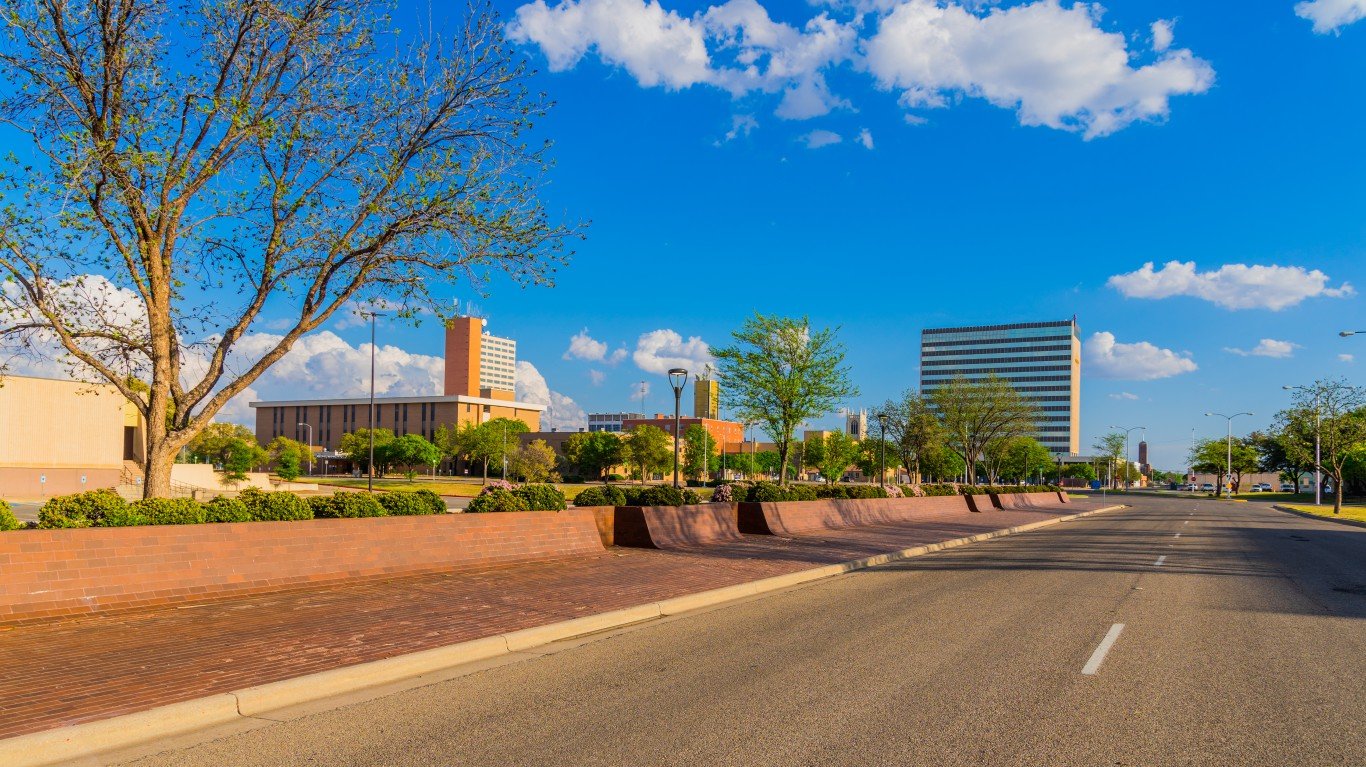
11. Lubbock, TX
> Violent crime rate: 919 per 100,000 people (2,985 total crimes)
> 1-yr. change in violent crime rate: +9.6%
> Homicide rate: 9.5 per 100,000 people (31 total homicides)
> Poverty rate: 18.3%
Six of the 50 U.S. metro areas with highest violent crime rates are located in Texas. Of those, Lubbock ranks as the most dangerous. Nearly 3,000 violent crimes were reported in the metro area in 2020, or 919 for every 100,000 people.
Lubbuck’s violent crime rate climbed by nearly 10% last year. The increase was led by a 182% surge in homicides, from 11 in 2019 to 31 in 2020. As a result, the local homicide rate of 9.5 incidents per 100,000 people is now well above the 6.5 per 100,000 national rate, while in 2019, the metro area’s homicide rate of 3.4 per 100,000 was far below the national rate of 5.1 per 100,000 that year. Local officials connect the surge in deadly violence to drug use, firearms, and domestic violence.
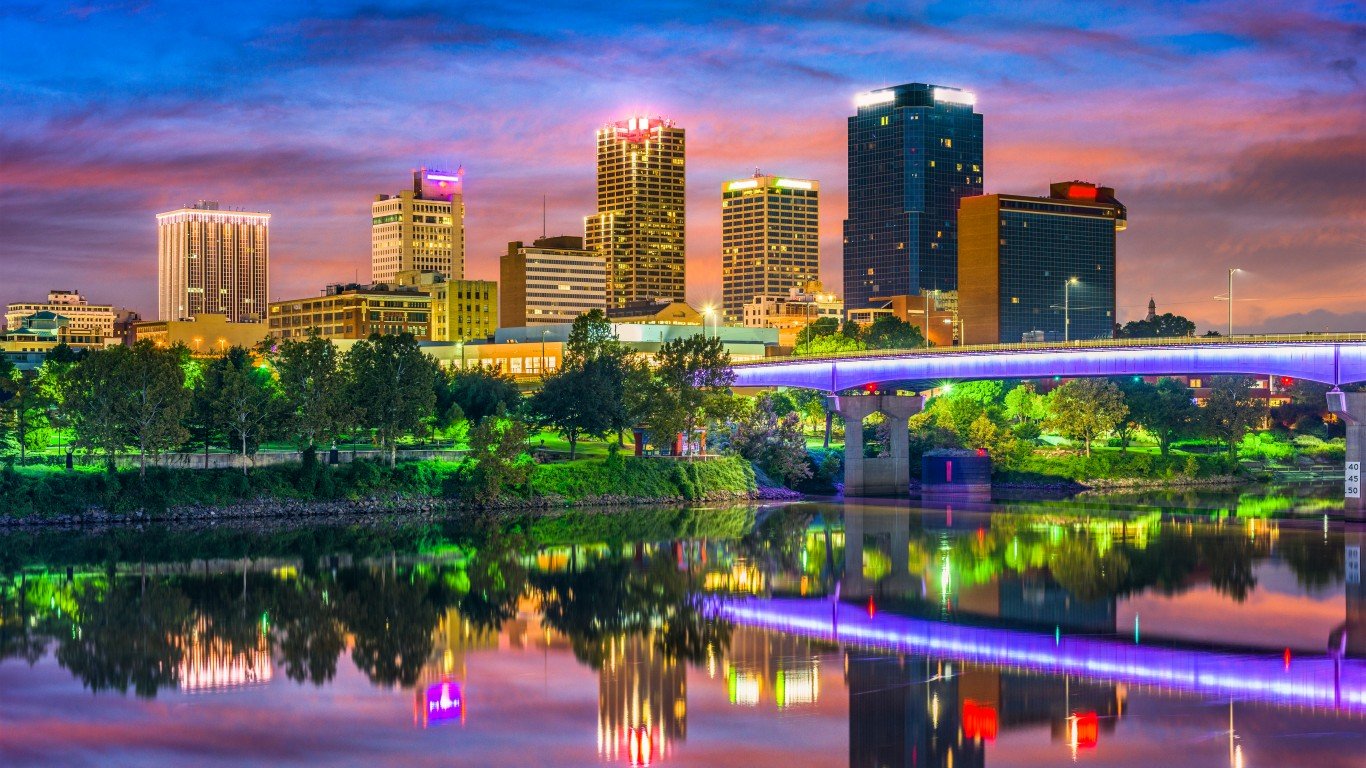
10. Little Rock-North Little Rock-Conway, AR
> Violent crime rate: 939 per 100,000 people (7,014 total crimes)
> 1-yr. change in violent crime rate: +20.0%
> Homicide rate: 13.1 per 100,000 people (98 total homicides)
> Poverty rate: 13.8%
Following a 20% spike in 2020, the violent crime rate in the Little Rock-North Little Rock-Conway, Arkansas, metro area now stands at 939 per 100,000 — higher than in the vast majority of U.S. metropolitan areas and more than double the national violent crime rate. The increase was driven by increases in homicides and aggravated assault cases.
In October 2021, Little Rock Mayor Frank Scott, Jr. announced a comprehensive plan to reduce violence in the city. The plan includes an increased police budget and signing bonuses for new officers. New strategies in law enforcement will include increased police visibility, increased surveillance, targeted policing, and expanded social services.
[in-text-ad]

9. Alexandria, LA
> Violent crime rate: 968 per 100,000 people (1,464 total crimes)
> 1-yr. change in violent crime rate: +14.0%
> Homicide rate: 14.5 per 100,000 people (22 total homicides)
> Poverty rate: 17.6%
The violent crime rate in Alexandria, Louisiana, of 968 incidents per 100,000 people is among the highest in the United States. Deadly violence is especially common in the metro area. There were 22 homicides in Alexandria in 2020, or 14.5 per 100,000 people — more than double the 6.5 per 100,000 national murder rate.
Deadly violence has continued into 2021. Less than three months into the year, the Alexandria Police Department reported 12 fatal shootings, compared to 22 total homicides in all of 2020.
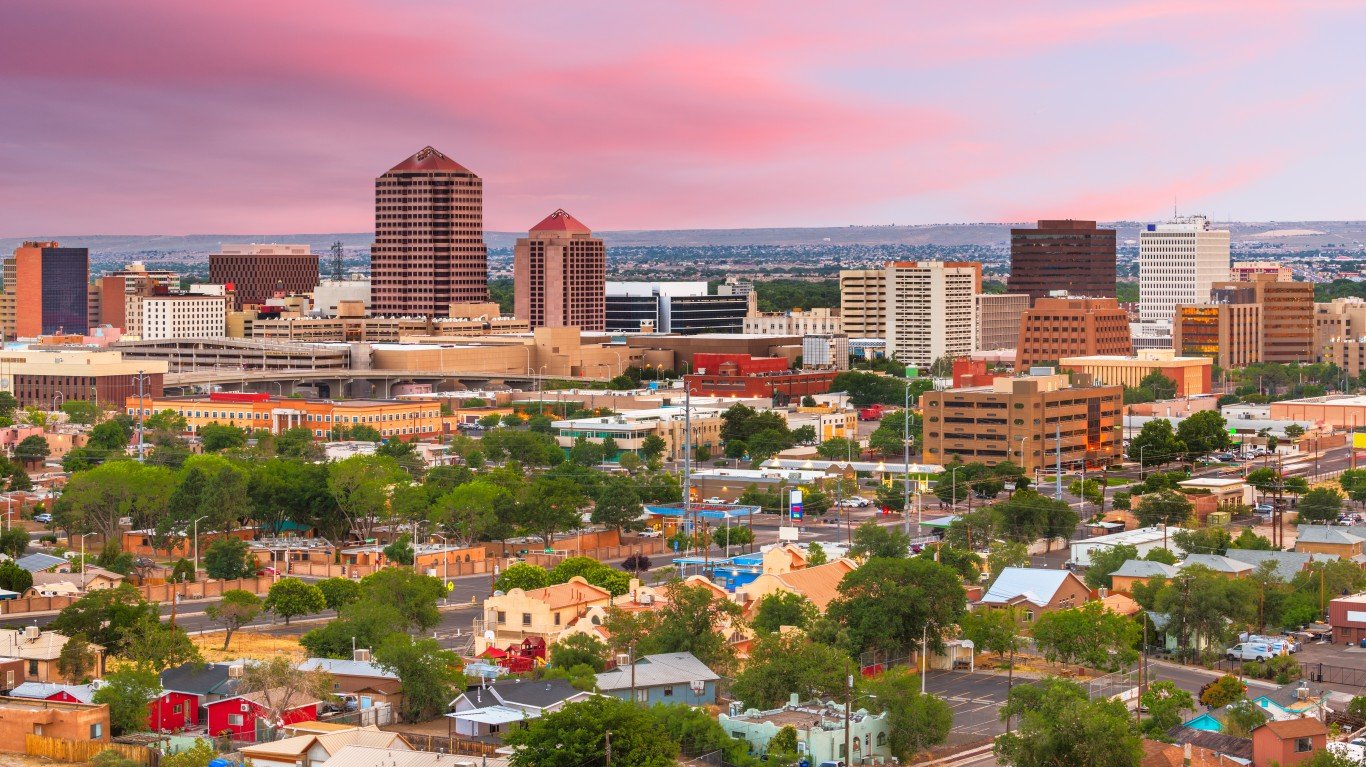
8. Albuquerque, NM
> Violent crime rate: 1,006 per 100,000 people (9,296 total crimes)
> 1-yr. change in violent crime rate: -3.6%
> Homicide rate: 9.4 per 100,000 people (87 total homicides)
> Poverty rate: 15.5%
In a break from the national trend, the violent crime rate is declining in Albuquerque, New Mexico. Still, despite the 3.6% decline, the local violent crime rate stands at 1,006 incidents per 100,000 people, well more than double the national rate and the highest of any Western state in the lower 48.
Local officials tie high levels of violence in the city to homelessness and financial hardship. An estimated 15.5% of the metro area population live below the poverty line, compared to 12.3% of all Americans.
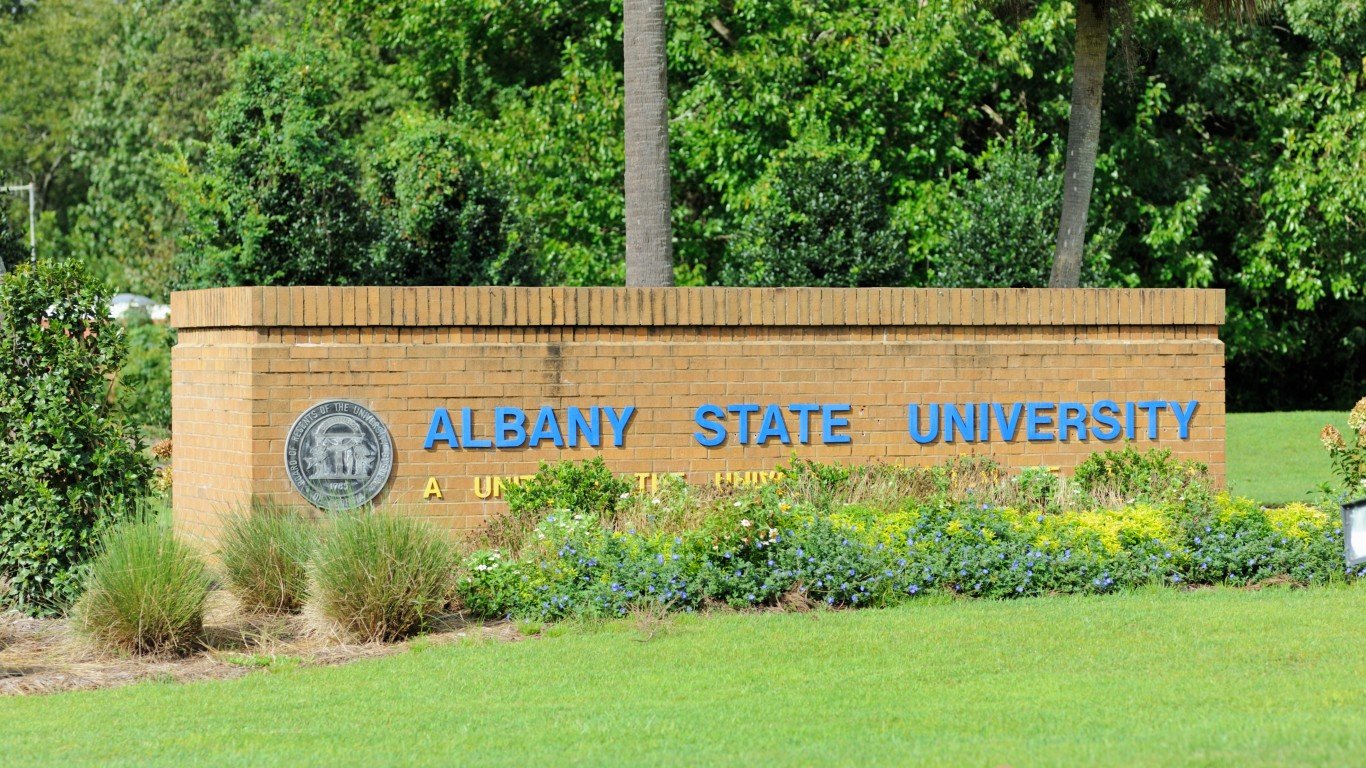
7. Albany, GA
> Violent crime rate: 1,008 per 100,000 people (1,469 total crimes)
> 1-yr. change in violent crime rate: +40.5%
> Homicide rate: 15.8 per 100,000 people (23 total homicides)
> Poverty rate: 22.6%
Following a near nation-leading 40.5% surge in violent crime in 2020, the Albany metro area stands alone as by far the most dangerous city in Georgia. Nearly 1,500 violent crimes were reported in the Albany metro area in 2020, or 1,008 for every 100,000 people. The increase was led by a 55% surge in cases of aggravated assaults and a near doubling of homicides — from 12 in 2019 to 23 in 2020.
As is often the case in metro areas with high rates of criminal violence, Albany is home to a disproportionately large share of residents facing severe financial hardship. The local poverty rate of 22.6% is considerably higher than the comparable 12.3% national rate.
[in-text-ad-2]
6. Danville, IL
> Violent crime rate: 1,050 per 100,000 people (785 total crimes)
> 1-yr. change in violent crime rate: +12.3%
> Homicide rate: 17.4 per 100,000 people (13 total homicides)
> Poverty rate: 16.5%
Danville is the most dangerous metro area in Illinois and the second most dangerous in the Midwest. There were 785 violent crimes reported in the metro area in 2020, or 1,050 for every 100,000 people. Deadly violence is especially common in the metro area. There were 13 homicides in Danville in 2020, or 17.4 per 100,000 people — well more than double the 6.5 per 100,000 national murder rate.
As is the case in much of the country, criminal violence is becoming more common in Danville. The local violent crime rate is 12.3% higher now than it was in 2019.
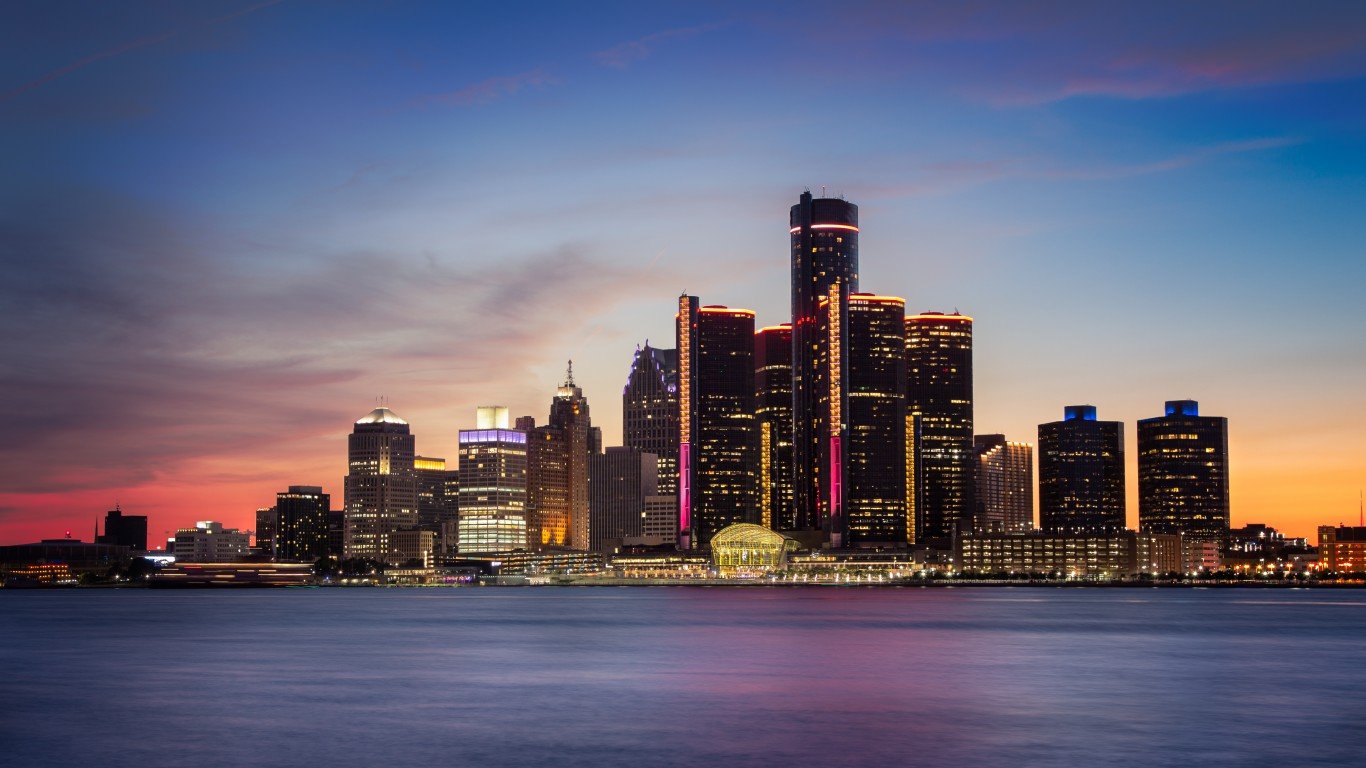
5. Detroit-Dearborn-Livonia, MI
> Violent crime rate: 1,088 per 100,000 people (18,894 total crimes)
> 1-yr. change in violent crime rate: +10.5%
> Homicide rate: 22.3 per 100,000 people (387 total homicides)
> Poverty rate: N/A
With a violent crime rate of 1,088 incidents per 100,000 people, Detroit is by far the most dangerous metro area in Michigan and the most dangerous in the Midwestern United States. There were 387 murders reported in the Detroit area in 2020, or 22.3 for every 100,000 people — the third highest homicide rate of any metro area.
Deadly violence in the city has continued in 2021. As of July, homicides in the city were on pace to eclipse the number reported in 2020.
[in-text-ad]

4. Pine Bluff, AR
> Violent crime rate: 1,098 per 100,000 people (950 total crimes)
> 1-yr. change in violent crime rate: +22.6%
> Homicide rate: 27.7 per 100,000 people (24 total homicides)
> Poverty rate: 23.6%
Pine Bluff, Arkansas, ranks as the most dangerous metro area in the state and fourth most dangerous nationwide. Following a 22.6% year-over-year increase, Pine Bluff’s violent crime rate stands at 1,098 incidents per 100,000 people, nearly three times higher than the U.S. violent crime rate. In an encouraging break from the national trend, however, homicides declined in the metro area last year, from 28 in 2019 to 24 in 2020.
According to Pine Bluff Mayor Shirely Washington, the area’s high crime rates are one of the factors contributing to steep population decline in the area. Between 2010 and 2020, Pine Bluff reported a 12.5% population decline, the largest drop of any U.S. metro area over that period.
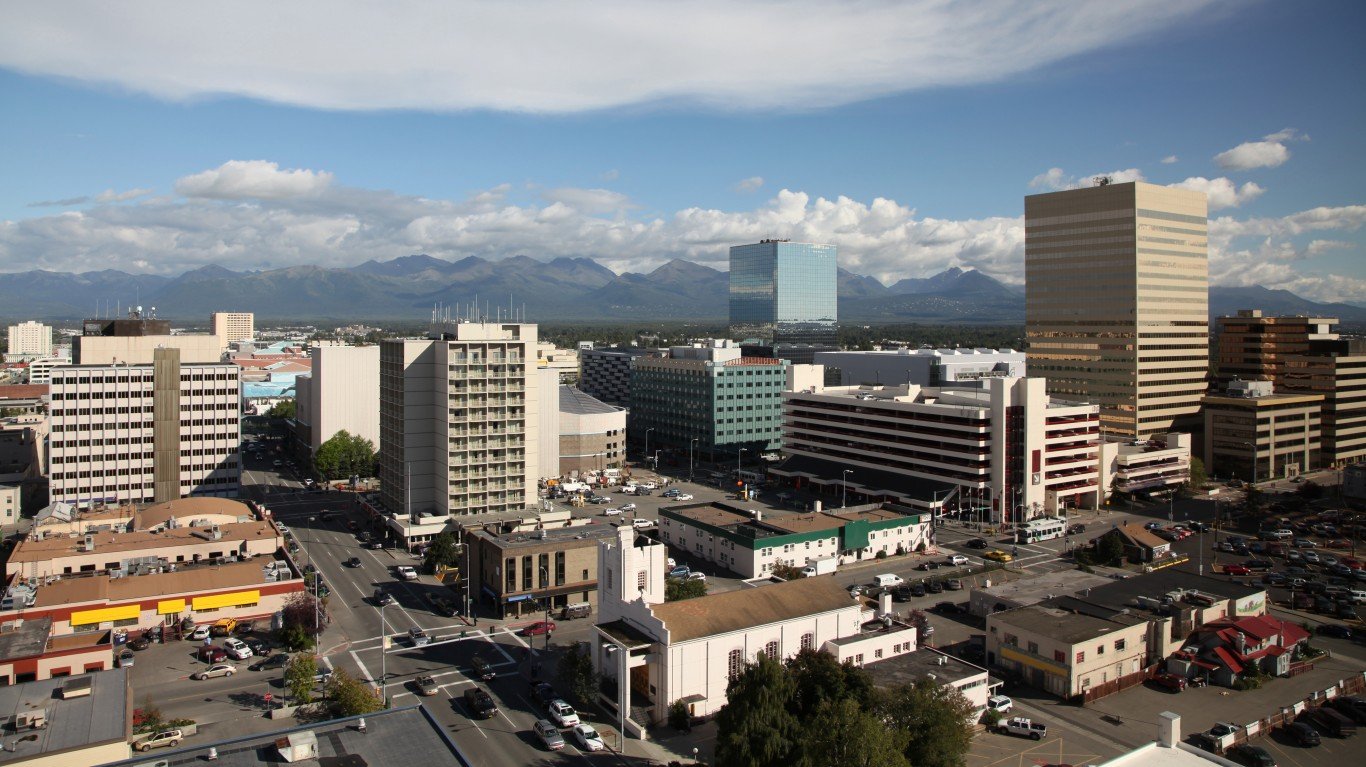
3. Anchorage, AK
> Violent crime rate: 1,171 per 100,000 people (3,576 total crimes)
> 1-yr. change in violent crime rate: -1.9%
> Homicide rate: 5.9 per 100,000 people (18 total homicides)
> Poverty rate: 10.0%
Despite a 1.9% annual decline in the violent crime rate, Anchorage, Alaska, is the most dangerous metro area in the Western United States and the third most dangerous metro nationwide. There were 3,576 violent crimes reported in Anchorage in 2020, or 1,171 for every 100,000 people, nearly three times the national violent crime rate.
In a break from the national trend, homicide cases declined precipitously in Anchorage, from 34 in 2019 to 18 in 2020. According to a police spokesperson, homicides in the metro area typically involve domestic disputes and, increasingly, drugs.

2. Monroe, LA
> Violent crime rate: 1,309 per 100,000 people (2,605 total crimes)
> 1-yr. change in violent crime rate: +61.0%
> Homicide rate: 11.6 per 100,000 people (23 total homicides)
> Poverty rate: 26.0%
Five of the 50 U.S. metro areas with highest violent crime rates are located in Louisiana. Of those, Monroe ranks as the most dangerous. More than 2,600 violent crimes were reported in the metro area in 2020, or 1,309 for every 100,000 people — more than three times the U.S. violent crime rate. The near nation-leading levels of violence in the city are partially the result of a crime surge that drove the violent crime rate up by 61% from 2019 to 2020.
The city police chief attributes the rise to the COVID-19 pandemic as well as to a rise in drug activity and use of illegal firearms.
[in-text-ad-2]
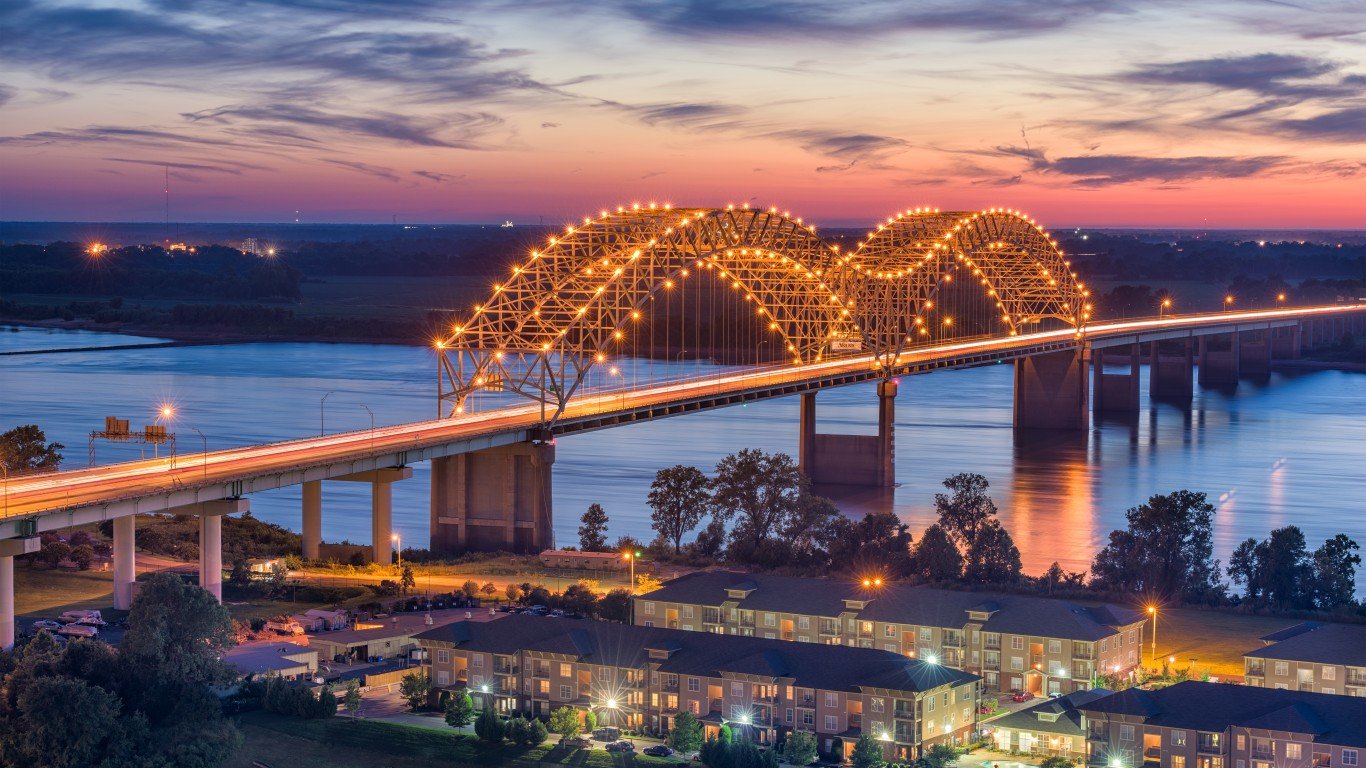
1. Memphis, TN-MS-AR
> Violent crime rate: 1,359 per 100,000 people (18,324 total crimes)
> 1-yr. change in violent crime rate: +21.3%
> Homicide rate: 24.2 per 100,000 people (327 total homicides)
> Poverty rate: 15.4%
The Memphis, Tennessee, metro area ranks as the most dangerous city in the United States. More than 18,000 violent crimes were reported in the metro area in 2020, or 1,359 for every 100,000 people — more than three times the U.S. violent crime rate. The number of homicides committed in Memphis climbed by 38%, from 237 in 2019 to 327 in 2020. At 24.2 per 100,000 people, the homicide rate in Memphis is the second highest of any U.S. metro area.
Deadly violence continues to rise in Memphis. The city has reported more homicides so far in 2021 than it had over the comparable period the previous year. City leaders have plans to curtail criminal violence in the city, but reportedly need hundreds more police officers to execute those plans. The department is reportedly offering a $15,000 signing bonus in order to aid in the recruitment effort.
Sponsored: Want to Retire Early? Here’s a Great First Step
Want retirement to come a few years earlier than you’d planned? Or are you ready to retire now, but want an extra set of eyes on your finances?
Now you can speak with up to 3 financial experts in your area for FREE. By simply clicking here you can begin to match with financial professionals who can help you build your plan to retire early. And the best part? The first conversation with them is free.
Click here to match with up to 3 financial pros who would be excited to help you make financial decisions.
Thank you for reading! Have some feedback for us?
Contact the 24/7 Wall St. editorial team.
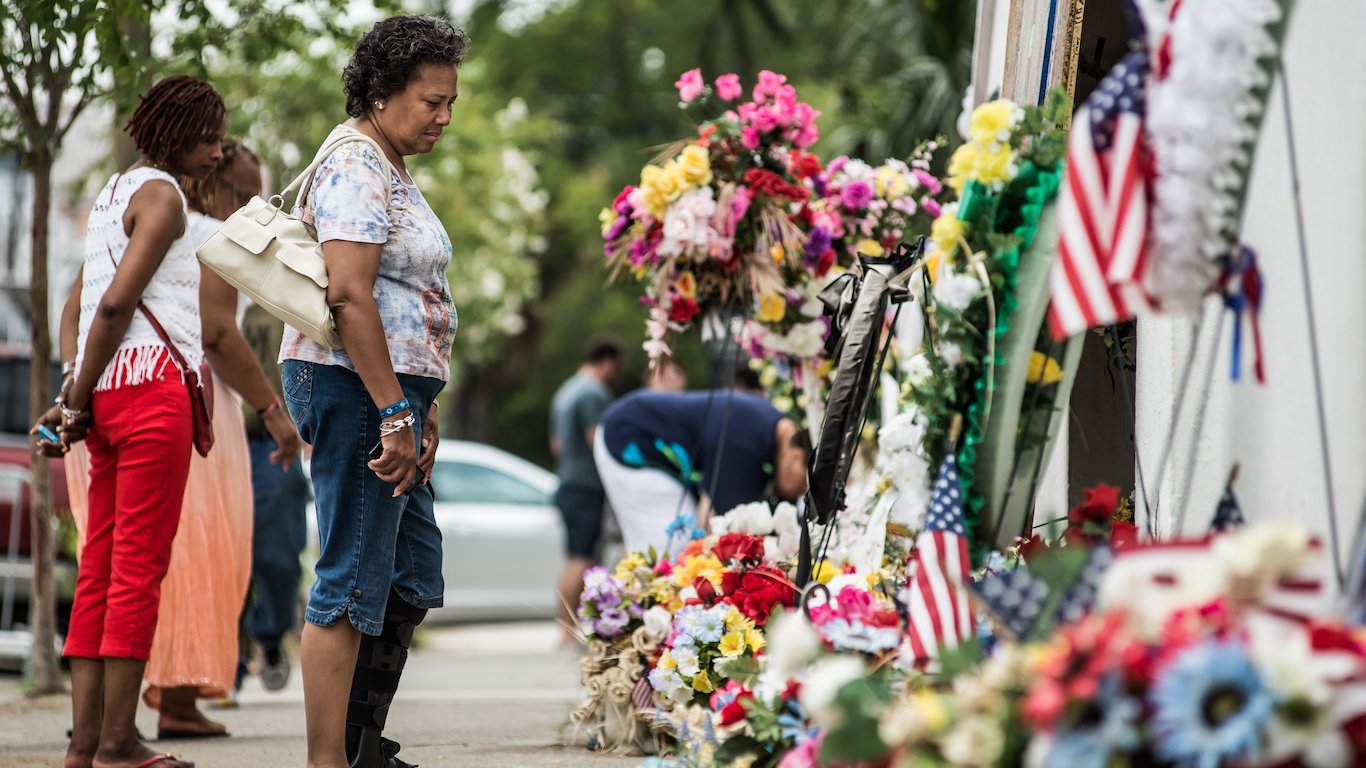 24/7 Wall St.
24/7 Wall St.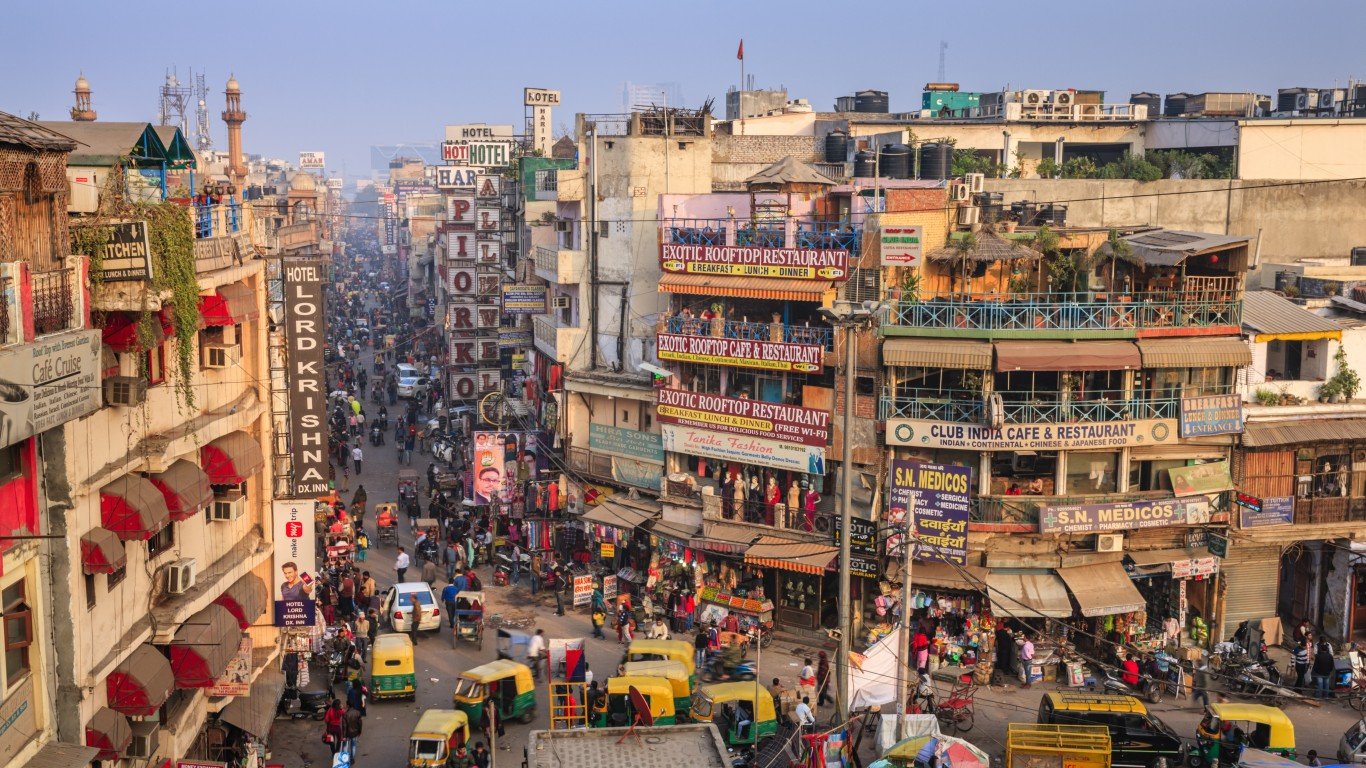 24/7 Wall St.
24/7 Wall St. 24/7 Wall St.
24/7 Wall St.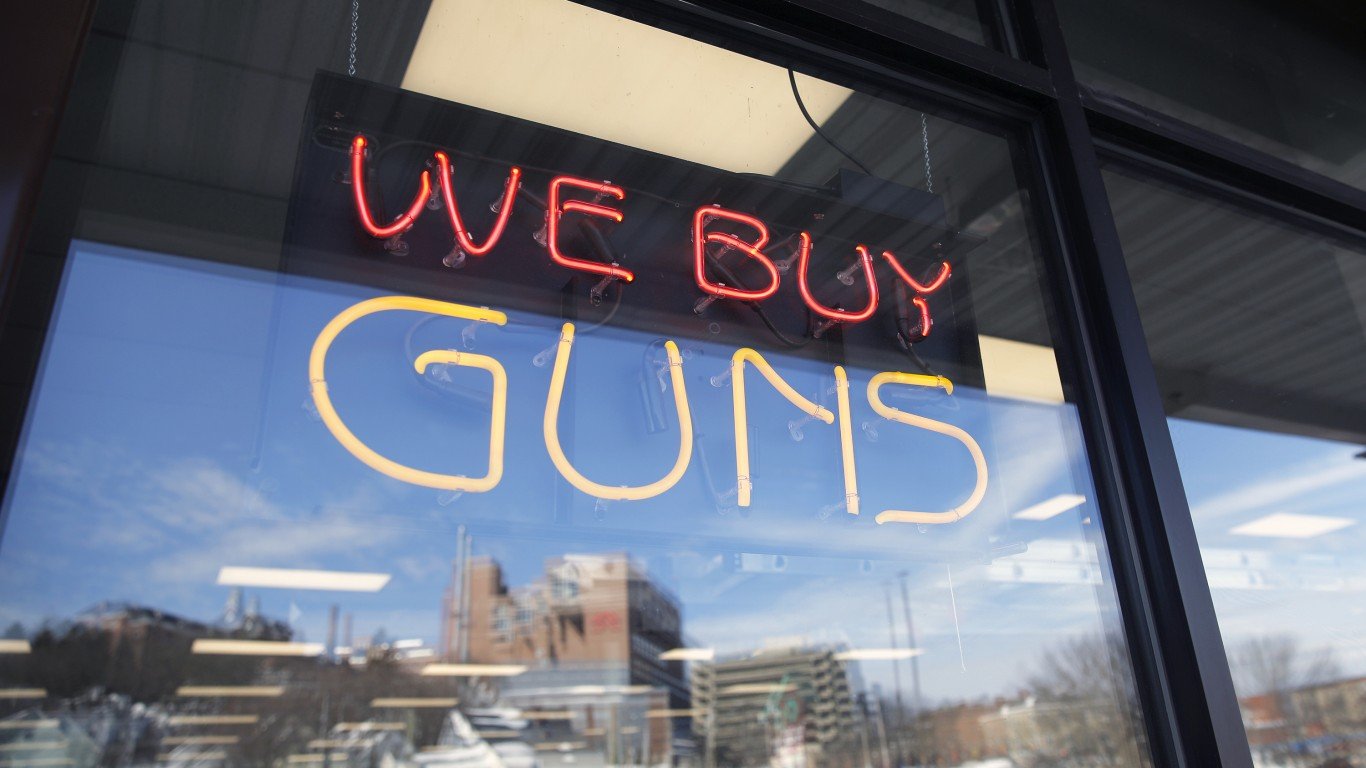 24/7 Wall St.
24/7 Wall St.